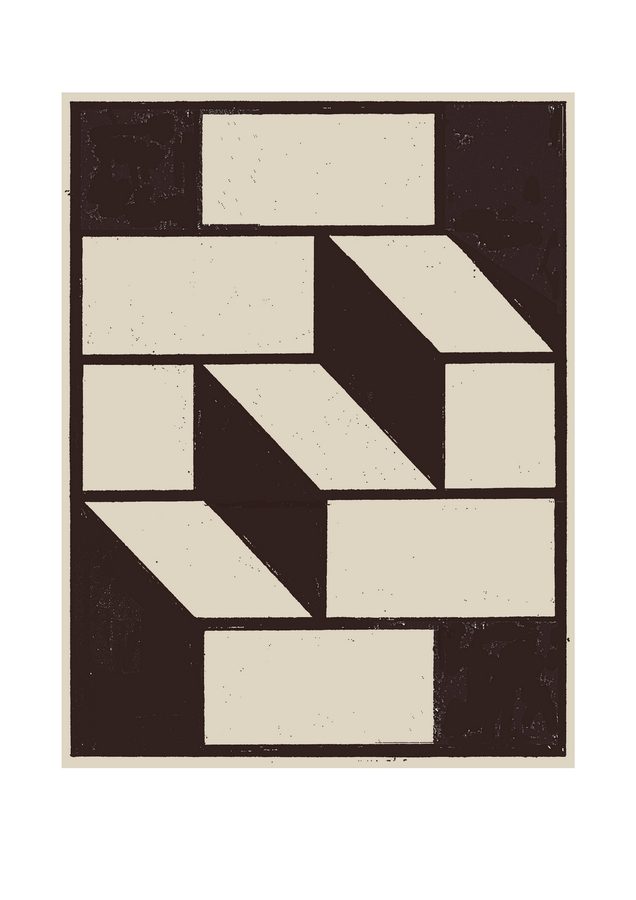
Two coloured digital print. 20 + 5 E.A.
I try to treat my source material as a precious find and with a great deal of respect. I refer to historical abstraction and at the same time try to catalogue my own world.
300 € net

Two coloured digital print. 20 + 5 E.A.
I try to treat my source material as a precious find and with a great deal of respect. I refer to historical abstraction and at the same time try to catalogue my own world.
300 € net
Farb- und Rasterfolien auf gefaltetem Papier.
20 + 3 E.A.
Drei Exemplare:
folder R-1697.323.323 [purple, sold]
folder R-1648.307.307.307 [black]
folder R-1512.1512.1512.1512 [grid]
Die Arbeit beschäftigt sich mit dem Verhältnis von Norm (DIN A4) und geometrischen Grundformen, dem Quadrat, dem Dreieck und dem Kreis. Über die Momente von Faltung und Beschichtung entstehen räumliche und architektonische Bezüge. Mit den Rasterfolien wurden besonders in den 60er und 70er Jahren die Pläne und Blaupausen für die architektonischen Planungen erstellt. Die unterschiedlichen Punkt- und Linienraster überlagern sich zu irritierenden Strukturen, die wieder an städtebauliche Strukturen der Moderne erinnern können.
500 € net
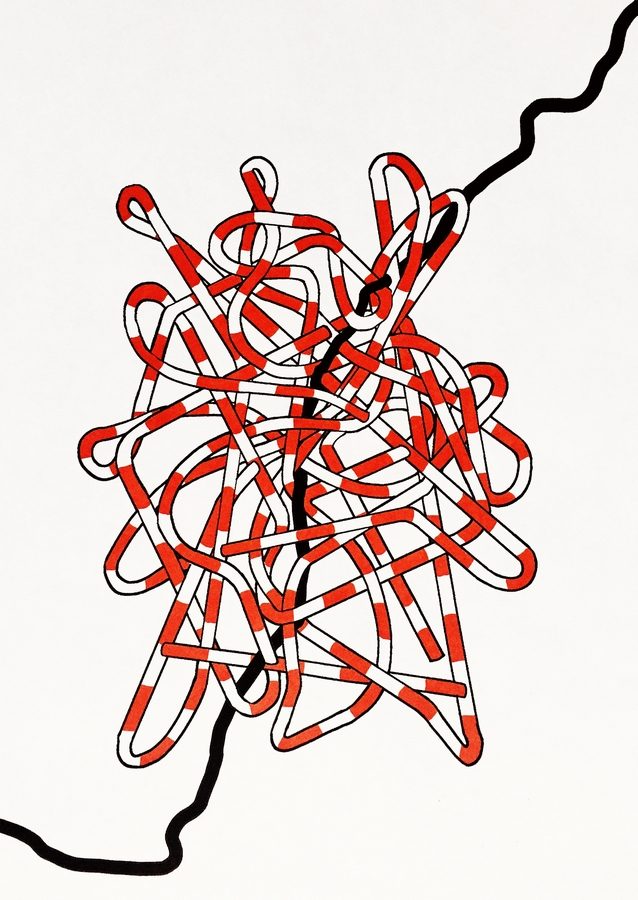
Acrylic and Screenprint on Cotton Rag Paper. 10 + 2 E.A.
The work focuses on Bauhaus’s complicated history of existence at three different locations as well as its gender politics. Due to the political climate of that time, shifts of focus, technique and instructors, the school moved three times over the total distance of 305 km. The measured space between the Weimar’s, Dessau’s and Berlin’s locations is depicted in the 1:100 000 scale of the weaved lines. The black line that traverses the tangled knot serves as a visual representation of the road between those locations. Both the structure as well as the title of the work are based on the “Knots” series executed by Anni Albers in the late 40’. Albers was a Bauhaus student since 1922. After 1931 she became the Head of the Weaving Workshop, which made her one of the very few women to hold such a senior role at the school. The Weaving Workshop was at first a neglected part of the Bauhaus that later became one of its most successful facilities. In a way, although the school fronted progressive ideas of gender equality, it still maintained many barriers for women (different standards in the acceptance policy for women, redirecting female students into more domestic subjects of weaving, or ceramics, etc.). Anni Albers developed many functionally unique textiles combining properties of light reflection, sound absorption, durability, and minimized wrinkling and warping tendencies and played a fundamental role in the development of the Bauhaus school’s weaving program.
250 € net
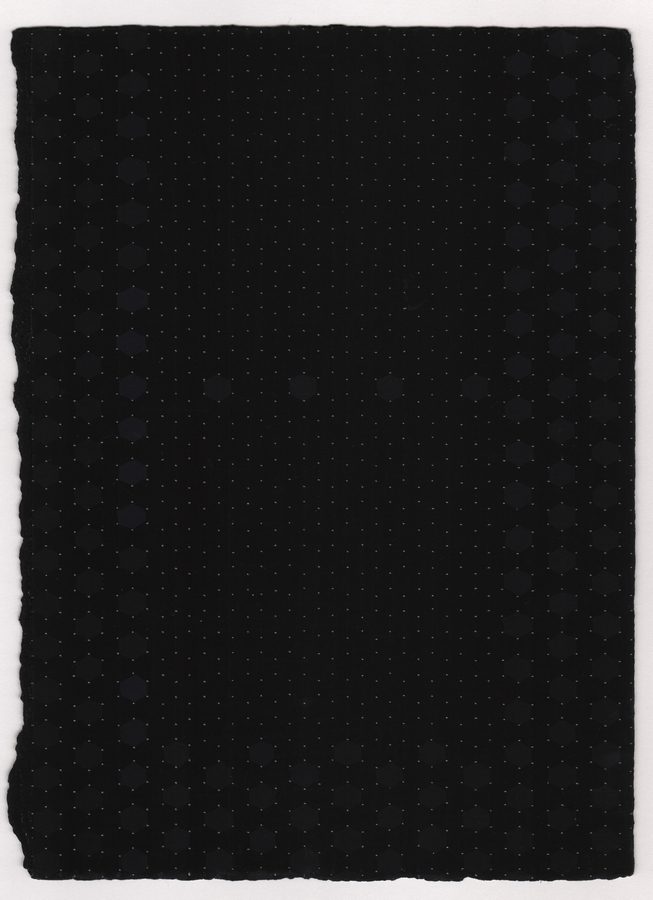
Gouache and graphite on paper. 3 unique works
These drawings are made with gouache and graphite on paper. They are each originals, hand made with slight variations. The titles reference my association to an Albers image (a small postcard) that hangs in my studio. I’ve had an Albers image (Study of the Homage to the Square, Departing in Yellow, 1964) on my studio wall for two years, it hangs next to an old photograph of my mother (a poor child of Appalachia, she’s standing in a doorway of a shack) that was taken in the 50’s, the photograph is square, a common format in mid-century photography. My mother is three years old in the photograph, she is a different form, a different being from the woman in which I now know. The Albers composition that hangs adjacent to my mother is from the Tate, a postcard that I picked up while traveling in London. When I saw the painting for the first time during this trip, my best friend Nicole was in the final stages of cancer (transforming, departing) and I saw this abstract painting as light to another dimension, a doorway, a way to enter and to exit. I think a lot about the movement of the Bauhaus artists during their lifetime, how they left home, to find new spaces to live and to work. I think a lot about how external conditions effect the human spirit, how we are transported by things that we cannot control. For two weeks every fall, the tree outside of my studio window in Brooklyn becomes the exact same color as the center square of the Albers, it usually coincides with my friend Nicole’s birthday.
1.000 € net
unavailable
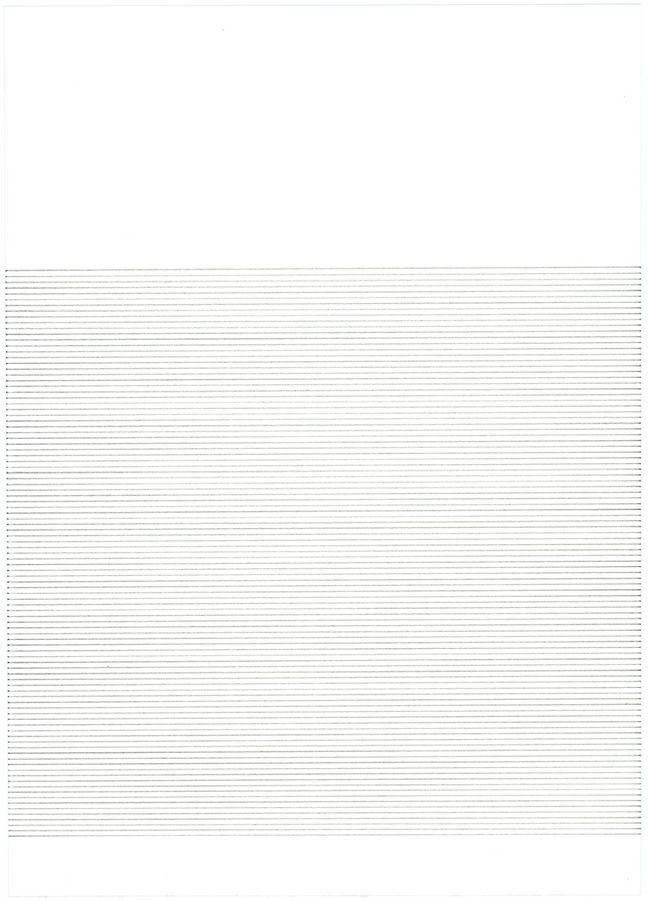
Pencil on Paper. Serie von 10 Unikaten
„Die Waagerechte ist die Verbindung der auf Augenhöhe liegenden Raumpunkte auf der Augenlinie.“ (Paul Klee). In: Paul Klee, Das Bildnerische Denken. Beiträge zur bildnerischen Formlehre: Vorlesungen am Bauhaus in Weimar und Dessau (1921-1931): “Linie, Fläche und die Orientierung im Raum“, Hrsg: Jürg Spiller, Basel/ Stuttgart, 1956, S. 146
100 € net
No. 4 to 10 available
Paper, layered and cut. 3 unique works.
Das Quadrat symbolisiert die ruhende Materie, der Kreis symbolisiert den ewig bewegten Geist. So die Bekundung durch Johannes Itten in seiner Farbenlehre. Wenn man sich dieser Aussage gedanklich annähert, so denkt man anfänglich, dass die Ruhe und das Bewegte etwas Gegensätzliches sind und somit die Harmonie ausschliessen. Das Werk hier vermag aber in Ittens Sprache zu sprechen und zeigt uns, dass diese zwei Pole, im Auge des Betrachters, eine ruhige Klarheit schafft. Eine reduzierte Formsprache, so wie sie zu Bauhaus Zeiten erstrebenswert war.
Two available.
370 € net
Aquarell, Tinte, Farbe. 10 + 3 E.A.
inspiriert von Gertrud Grunow, die mit Farbe, Bewegung und Klang arbeitete.
Sie war Pionierin der ‘Synthetischen Pädagogik’ am Bauhaus.
250 € net
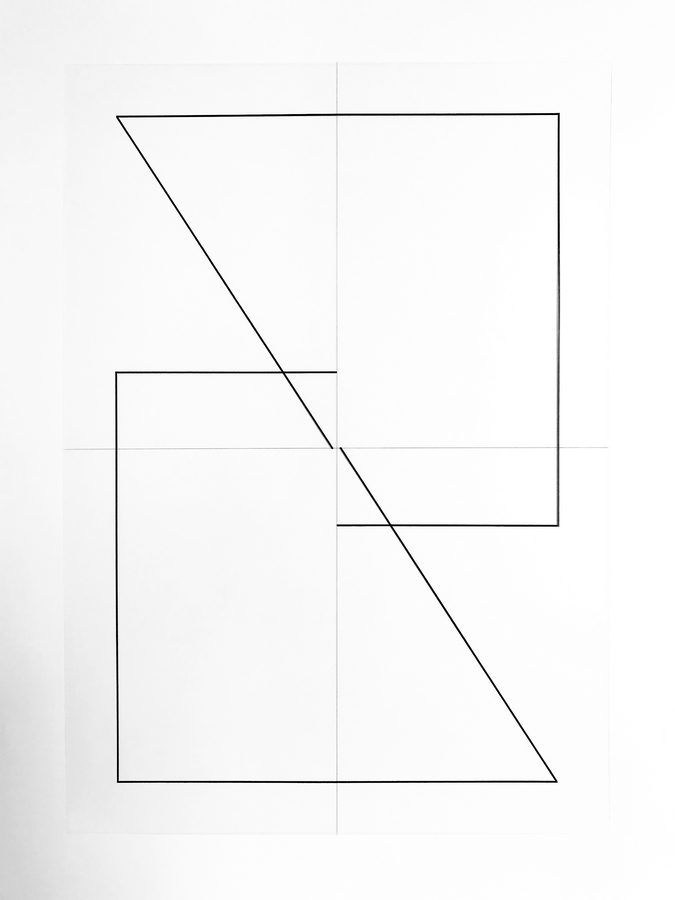
(CTF) Computer to Film. 20 + 3 E.A.
Der Offsetdruck leitet vom Zeitalter der industriellen Produktion über in das Zeitalter des digitalen produzierens. Gleichsam sind seine Mittel in den Druckvorstufen in seiner Anfangszeit noch geprägt vom Lithografischen Druckverfahren (erfunden 1796 von Alois Senefelder) mit schweren Steinplatten, lösen sich davon aber zügig und die Steinplatte wird alsbald ersetzt durch Druckplatten aus Metall (erste Offsetmaschine geht 1910-1912 in Leipzig auf den Markt) und später mit Film. Der entwickelte Film wird auf eine beschichtete Platte gelegt, diese wird belichtet und entwickelt. Dieses Verfahren wurde im Zuge der Computerisierung, durch das Verfahren Computer to Film (CTF) abgelöst und später wiederum durch das Verfahren CTP (Computer to Plate) ersetzt. Heute markiert das CTF – Computer to Film Verfahren die letzte Station vor der kompletten Digitalisierung der Druckvorstufe. Mit der fort-schreitenden Computerisierung starben Berufe wie der des Retuscheurs und des Druckformenherstellers aus. Die Verwendung von Film als Druck-form ist damit das letzte Zeugnis einer Produktionskette in dessen Abfolge des Herstellungsprozesses der Mensch als solcher noch involviert ist.
300 € net
Collage with Coloured Adhesive Labels on Paper. 3 + 3 E.A.
Der Titel ANNI bezieht sich auf Anni Albers.
450 € net
unavailable
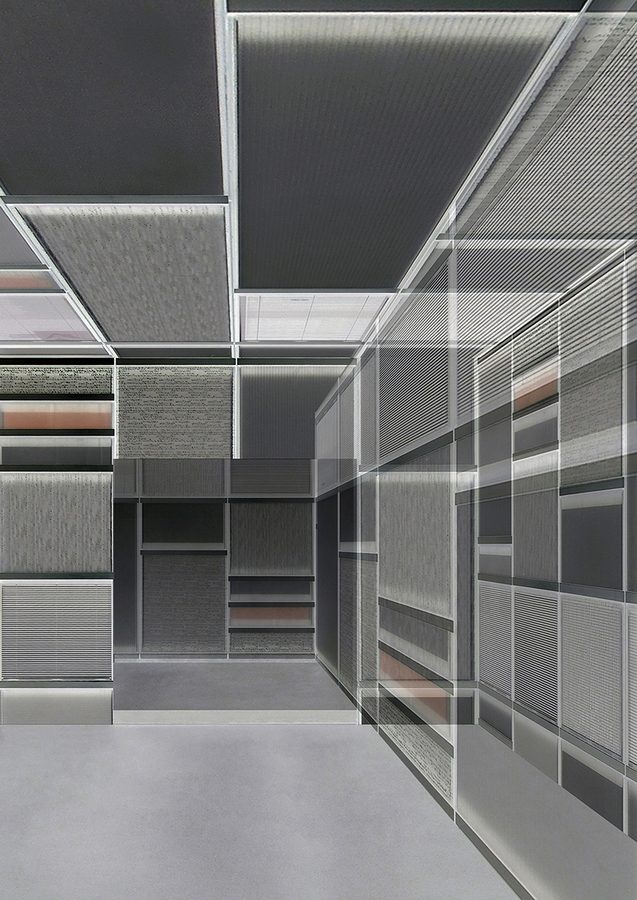
Digital Print on Laid Paper. 20 + 1 E.A.
The piece is based on my work series virtual interiors, concepts for site specific spatial installations made out of photographs of selected architecture as built heritage of Bauhaus and Modernity. The Virtual Interiors oscillate between utopian promise and dystopian inhospitableness of cities, between an aesthetic of the constructive minimal, and a chilling monotony of the serial, between authenticity and illusion. I am scaling photographs of façade fragments of modern or mass architecture and translocate them from urban space to inner rooms by lining real spaces with virtual façades. Bauhaus revisted VI IdlV represents a mixture of real and fictive space: The boundary between inside and outside, between private and public, between real and virtual become blurred.
500 € net
Watercolor on paper. Series of 13 unique drawings
…
980 € net
#2 & #3 available
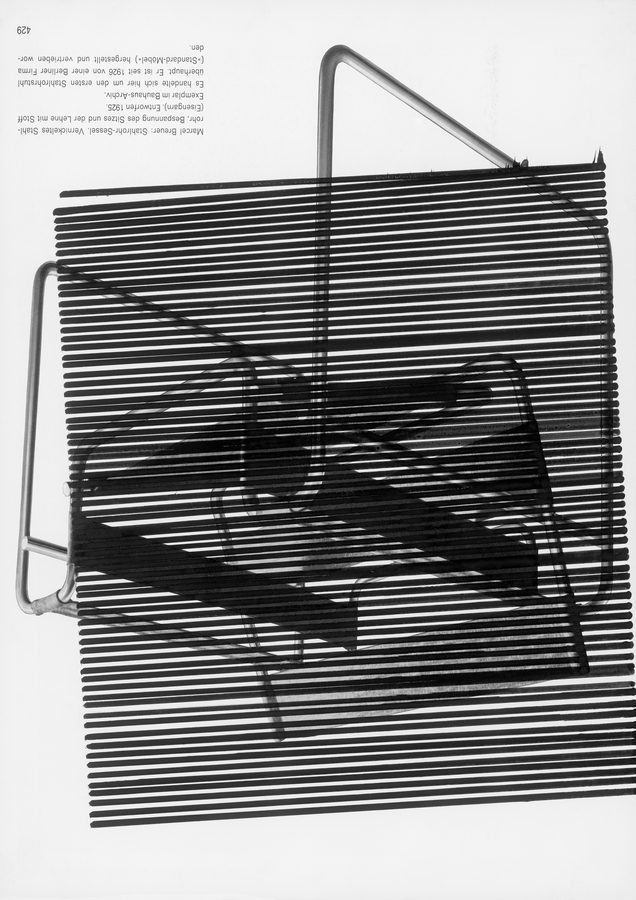
Digitaldruck auf Papier. 4 + 1 E.A.
Kannibalismus – oder – Bilder vom wiederholten Gebrauch. Der Form nach handelt es sich um eine im digitalen Druckverfahren hergestellte Edition von einer Linien-Zeichnung, welche mit Acrylmarker und Lineal auf einer kopfüber gewendeten Buchseite ausgeführt ist, die wiederum eine Reproduktion des „Stahlrohrsessels Wassily“ von Marcel Breuer, in dem berühmten Design aus dem Jahr 1925 zeigt. Marcel Breuers ikonisches Design des Stahlrohrsessels ist ein vielfach reproduziertes Sinnbild einer Idee von Moderne, die heute 100 Jahre zurückliegt. Inspiriert von der transparenten Funktionalität der Gestaltung und seiner gleichzeitigen Fetischisierung, übt der Stahlrohrsessel eine merkwürdig ambivalente Kraft auf mich aus. In der Überzeichnung dieser Reproduktion wird ein vieldeutiges Abbild der Überlagerungen von Bildschichten, im sich wiederholenden Gebrauch von unterschiedlichen Abbildern, sichtbar.
500 € net
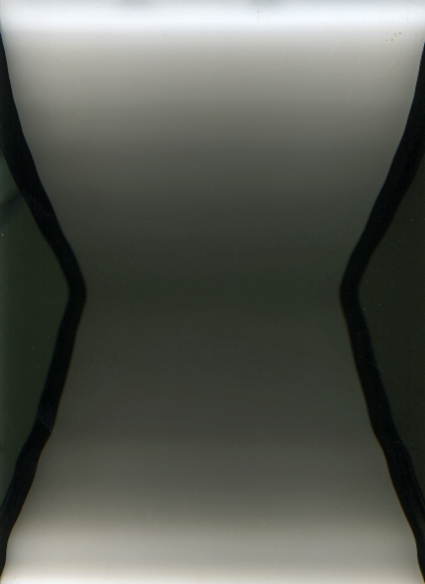
Photo Etching on Cotton Paper. 10 + 1 E.A.
Ausgangspunkt meiner Überlegungen für die Ausstellung CENTURY. idee bauhaus war das Nachdenken über meine persönliche ‚Idee Bauhaus‘. Wie verhalte ich mich zum Bauhaus, mit all seinen bereits ins kollektive Gedächtnis übergegangenen Ikonografien? Am nächsten steht mir der Gedanke, dass diese Hochschule einen nicht zu unterschätzenden Meilenstein in der Liberalisierung und Vermittlung von gestalterischen Arbeitsweisen und Grundlagen gesetzt hat, der bis heute Bestand hat: Keine Vermittlung formeller Grundlagen ohne pädagogische Konzepte und Ideen der Bauhaus-Schule. Ich selbst wundere mich in meinem Unterricht immer wieder darüber, welch großen Schlüssel Bauhaus für Studierende und künstlerisch interessierte Menschen darstellt, um Wirkungen im Bild zu untersuchen, Abstraktion zu verstehen und die Scheu im Umgang mit ‚Kunst‘ zu verlieren. Als jemand, der die Ästhetik des Bauhauses mit der ‚gestalterischen Muttermilch‘ aufgesogen hat, an deutschen Hochschulen zur Künstlerin ausgebildet wurde und jetzt selbst dort ausbildet, will ich meine Arbeit, die ich zu ‚idee bauhaus‘ beitrage, auf die mir sinnvollste Art und Weise verstehen: Als ein Artefakt eines geschichtlichen Prozesses, bei der die damals aufgestellte ‚idee bauhaus‘ noch hundert Jahre später als Echo mitschwingt und es nicht nötig hat, explizit darauf Bezug zu nehmen, sondern diesen Sockel nutzt, um eine ‚Idee‘ von Kunst weiter zu bearbeiten.
200 € net
Zur Arbeit:
Die Arbeit Scan_IMG_auf-zu_001.tiff, 2018 entstand im Prozess meiner künstlerischen Untersuchung aus der Idee heraus, zwei unterschiedliche technische Verfahren der Bilderzeugung und -reproduktion zusammenzuführen. Daran interessiert mich am meisten die Überführung einer banalen Handlung in ein Bild, das durch eine weitere mediale Transformation mit einer anachronistischen Widersinnigkeit aufgeladen wird. Dazu führten mich sowohl mein Interesse und künstlerisches Forschen an digitalen bildgebenden Verfahren, sowie deren Bedeutung für unsere Bildwahrnehmung und Wiedergabe, als auch meine handwerklichen Kenntnisse in der ‚traditionellen‘ Künstlerradierung. Die digitale Vorlage ist entstanden, indem ich während des Scanvorgangs (Dauer: ca. 2 sec bei 72 dpi) die Abdeckung eines Flachbettscanners geöffnet und wieder geschlossen habe. Die sichtbare Abbildung ist durch gesetzte Einflussfaktoren der Hard- und Software bestimmt. Mein Einfluss beschränkt sich auf das Bedienen der Klappe. Reproduziert wurde das entstandene Motiv in der Technik der Photoradierung. Dazu wird das Motiv mithilfe einer Vorlage in einem photochemischen Prozess auf eine Druckplatte übertragen und mithilfe einer Tiefdruckpresse gedruckt.
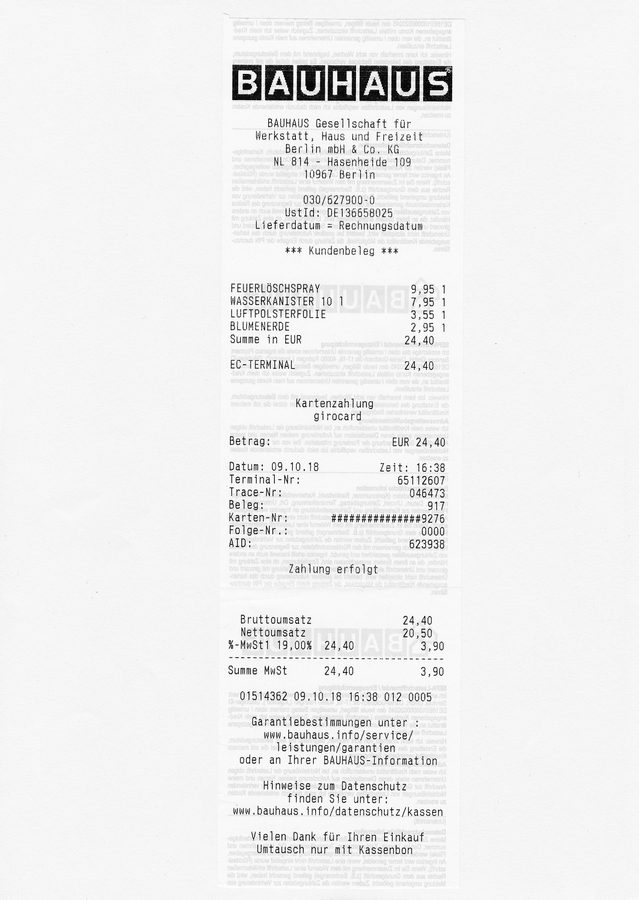
Inkjet print on paper. 100 + 1 E.A.
Gehe ins Bauhaus und suche die vier Elemente: Feuer, Wasser, Luft und Erde.
24,40 € gros
Digital Print on Photographic Paper. 2 x 50 + 1 Video
A series of 2 x 50 A4 digital prints, as well as a video of the variations, also in 2 copies. The prints are 50 variants of the same drawing of an imaginary architecture created in a 3D program and manipulated in photoshop. It is a search on the relationship between the present technology, shape, colour and perspective. The drawing is particular in that it follows the viewer and changes if we keep our eyes focused on the work while our body changes position. I hope this work aspires to be a synthesis of the Bauhaus spirit.
Each print 350 € net
Price of Video on request
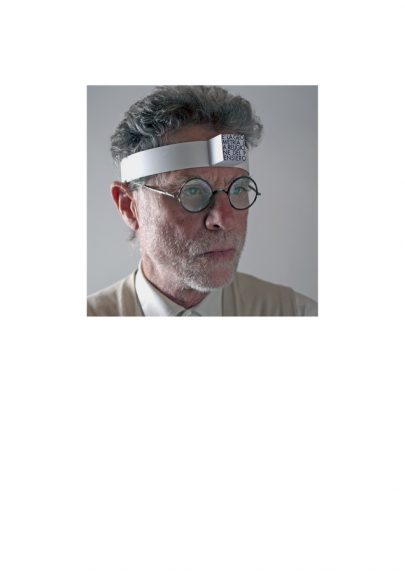
Certified ink jet print on 100% cotton paper. 3 + 1 E.A.
È la geometria la religione del pensiere. Is geomety the religion of thinking. Ist die Geometrie die Religion des Denkens.
350 € net
Ballpoint pen on paper. Unique drawings
Meine Kugelschreiber-Zeichnungen bestehen aus mit dem Lineal gezogenen Linien in den klassischen Kugelschreiber-Farben schwarz, rot, grün und blau. Ein zentraler Aspekt meiner Arbeit ist das Wechselspiel zwischen System und Zufall, Planung und Intuition. Der Prozess ist ähnlich linear und repetitiv wie beim Weben. Obwohl analog entwickelt, wirken die Zeichnungen teilweise wie computergeneriert. Den Februar 2019 verbrachte ich bei einer Residency der Josef and Anni Albers Foundation in Bethany, Connecticut, USA. Dort befindet sich auch das Albers Archiv. So habe ich noch mal einen besonderen Einblick in das Werk von Josef und Anni Albers bekommen. Für die Ausstellung CENTURY. idee bauhaus ist eine Serie von fünf Kugelschreiber–Zeichnungen entstanden. Für jede Zeichnung entwickle ich einen alphanumerischen Code, der aus Kürzeln der verschiedenen Parameter besteht: die Farbe der Linien, die Anzahl der übereinander gezeichneten Linienraster, der Abstand der Linien und ihre Ausrichtung zueinander. Der Code der hier gezeigten Arbeit KSZ 30/21–04 lautet: RA 1 / H 2 mm / R | RA 2 / H 2 mm / A1 (HL+2) / S | RA 3 / H 2 mm / A2 (HL–2) / B
1.500 € net
Two works available on request
Transparent paper, graphite, magic tape. 3 uniques
The folded works belong to two traditions of drawing: the demarcation of fields and the disegno – typified by the tradition of the deliberately drawn line. The single piece proceeds from an extremely reduced basic form. A curving line. The final drawing is a self-related sphere – a built selfrelation.
2.000 € net
unavailable
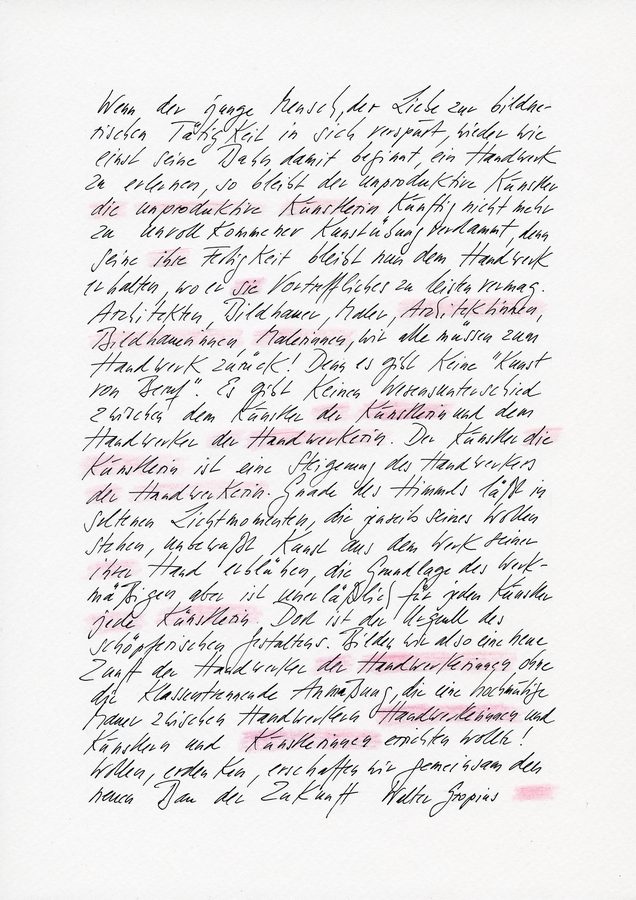
Tinte auf Zeichenpapier. Beliebig machbar
Im Jahr 2004 hatte ich mich einmal intensiv mit den ideen und Manifesten des Bauhaus beschäftigt für eine Klanginstallation in Chemnitz, die u.a. auf diesen Texten beruhte. Das Bauhaus war eine Männerdomäne, die Frauen landeten meist in den Webereiklassen und die Sprache des Manifestes von Gropius wäre heute wohl so nicht mehr möglich. Es gab engagierte Frauen im Bauhaus, in leitende Stellungen kamen sie so gut wie nie. Ich gestehe, daher ist das Bauhaus für mich nicht gerade ein Vorbild. Ich habe statt Kunst ganz handwerklich das Manifest von Gropius von 1919 abgeschrieben und leicht modifiziert.
100 net
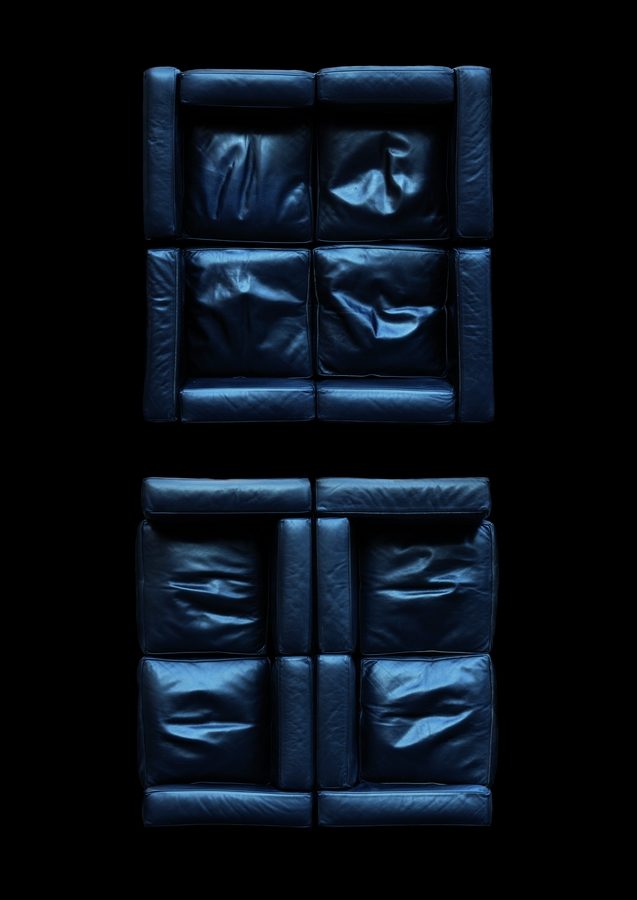
Fine Art Print on handmade paper. 20 + 3 E.A.
Zwei Le Corbusier LC2 2-Sitzer Sofas werden zu einem schwarzen Quadrat zusammengestellt und von oben fotografiert, so dass lediglich die Oberflächen der 4 Sitz- und der 8 Armlehnpolster zu sehen sind. Die geschlossene Form des einen Quadrats steht metaphorisch für die Einheit der Idee des Bauhauses, die offene Form des zweiten Quadrats für die Aufgeschlossenheit gegenüber und das mit Einbeziehen anderer Formen der Kunst und des Kunsthandwerks. Die Ausbeulungen der Sitzflächen und die Abnutzungen an den Rändern der Lederbezüge der beiden Sitzmöbel zeigen die Spuren der Zeit, die seit Gründung des Bauhauses vor hundert Jahren vergangen ist.
499 € net
Woven paper. 4 unique works from an edition of 4.
What began as research into the origins of patterns adorning ecclesiastical vestments of the Eastern Orthodox Church and depicted in Byzantine icons, has developed into explorations of the relationships between material, structure, and image as they relate to weaving in its simplest form. All three of these works are extracts from the same nonrepeating, 26 x 26 unit pattern. Strips of black paper are woven vertically through two sheets of white paper. The ends of the black strips are concealed between the two sheets of white paper so that the work can be viewed from either side; recto or verso. No glue is used. The parts are held together very securely through friction. When viewed from above or below, all of this is revealed..
750 € net
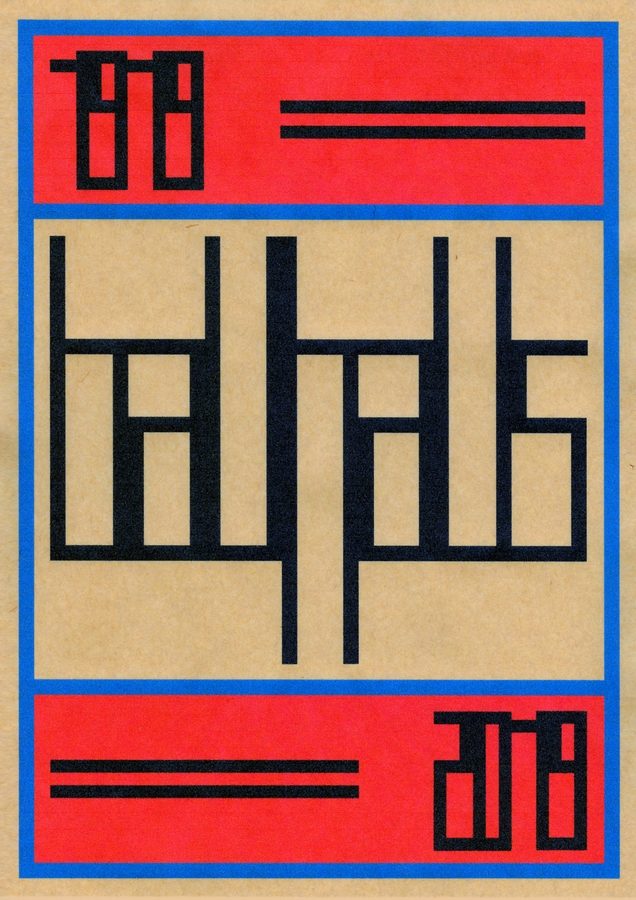
Digital Print on Sakae Technical Kraft Paper 70 gr. 3 + 3 E.A.
MY BAUHAUS is reflecting to basic modes of practice during the BAUHAUS area. Creating clear and functional work responding to conditions of life and society. MY BAUHAUS is built as an architectonic construction of typography from the word BAUHAUS itself, including the time period of 100 years since its founding. The contemporary Japanese Sakae Technical Kraft Paper is indicating the international significance of BAUHAUS till this day.
500 € net
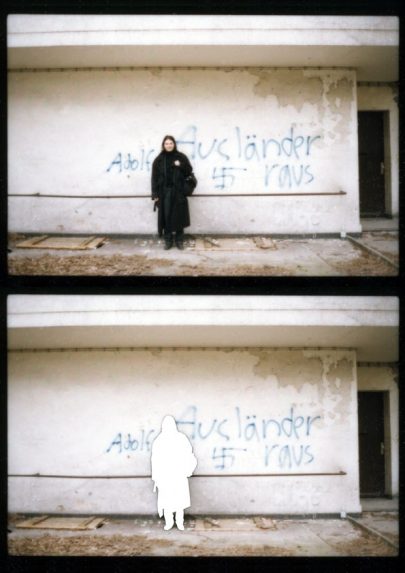
Archival print on paper, cut. 10 + 2 E.A.
In 1992, I visited the Bauhaus Building and the Meisterhäuser (Master’ Houses) in Dessau, Germany. The Meisterhäuser were closed and in very bad condition. On an outside wall I found a graffiti tag reading “Ausländer raus (Foreigners out) – Adolf” accompanied by a swastika. I took a self portrait in front of the wall. In 1995 I used this photo in my series “Absent Subjects,” cutting out my figure from the wall. In 2018 I composed both photos (with and without subject) for a juxtaposition beetween the past and the current political state.
700 € net
Acrylic Paint. 3 unique works
Deb Covell is a painter who celebrates the material qualities of paint by rejecting pictorial imagery and eliminating the traditional canvas support in an attempt to create paintings without restriction. In these new paintings, which she has made specifically for The Century exhibition, she follows both a systematic and intuitive approach. Each painting begins with a series of overlapping oblique coloured bands of various widths referencing the modernist colour palette. The overlapping diagonals set up illusionistic spatial depths and dynamic tensions. This process continues until the diagonals give way to horizontal and vertical bands of almost equal widths, shrinking the picture plane and collapsing any illusionary depth created, until a balanced composition emerges which belies the internal narrative and pictorial space that resides within it.
220 € net
One work available
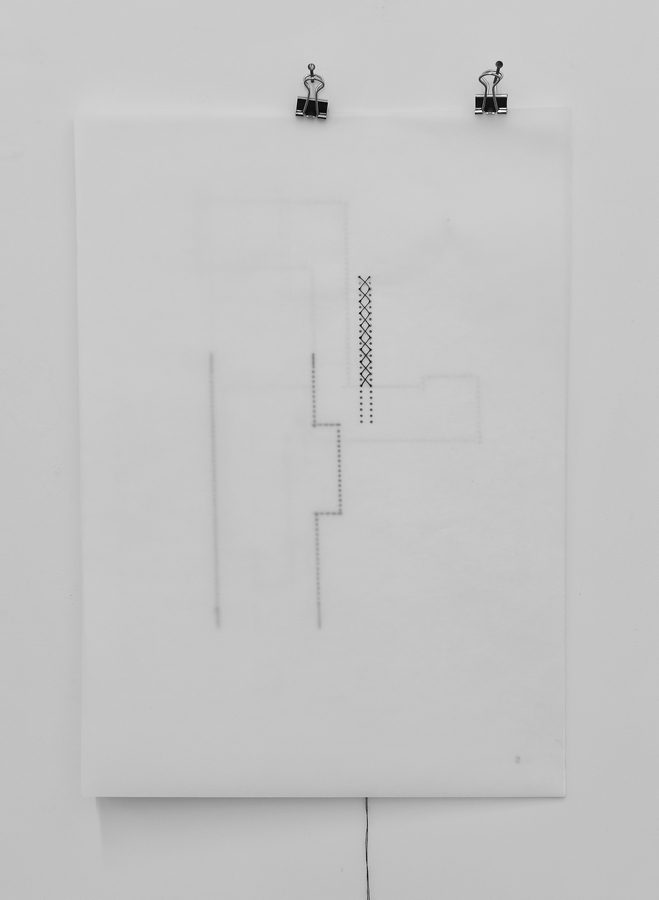
Different Papers, thread. Uniques
Per Schreibmaschine sind drei Grundrisse [die der drei Bauhäuser].auf dünnes Papier getippt. Dabei wird zwischen jedes Blatt ein Kohlepapier gelegt. Der Strich bzw. der Punkt verändern Form und Intensität von Blatt zu Blatt. Die Blätter sind mit einem dünnen Nähgarn durch Kreuzstich miteinander verbunden. Das vordere Blatt, ein Transparentpapier, hält die drei dahinterliegenden Blätter allein durch das Garn fest. Das Garn selbst ist auf der Rückseite der Blätter unverschlossen, also ohne Knoten. Der Kreuzstich ist die älteste Stickerei und überall auf der Welt verbreitet. Für gewöhnlich wurde er zur Verzierung von Tüchern, Kleidung und Haushaltswaren und vor allem von jungen Mädchen angewandt.
500 € net
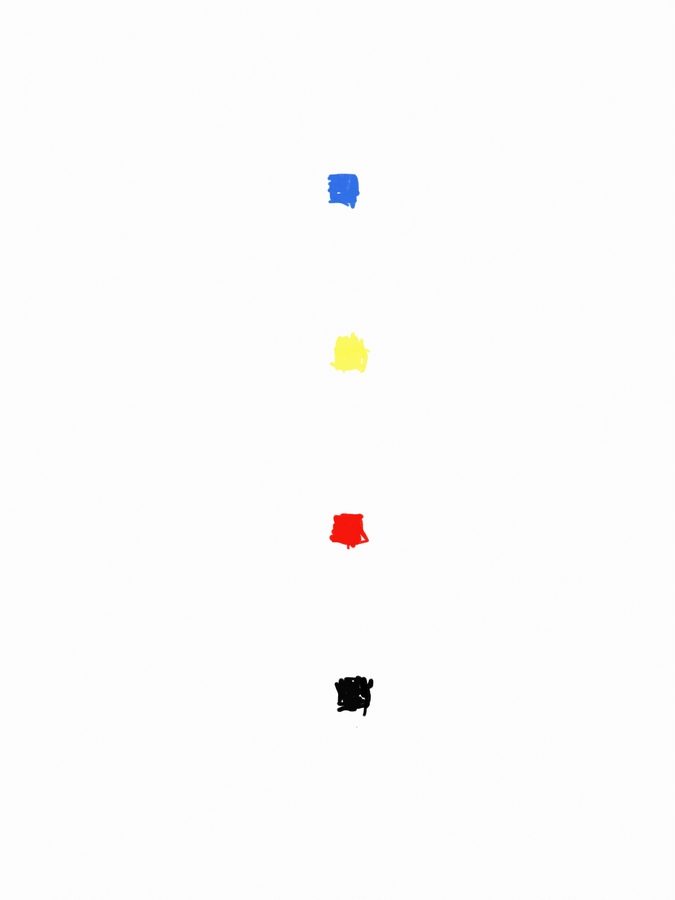
iPad Drawing, Digital Print on Hahnemühle. 20 + 3 E.A.
Meine Versuche das BAUHAUS und seine Auswirkung auf die Kunst der Moderne und schließlich auf meine eigene Kunstpraxis genauer zu fassen, zu begrenzen oder zu benennen, endeten unbefriedigend. Es scheint mir fast unmöglich, die internationale Wirkung, die sich in diesen 100 Jahren entfaltet hat, zu unterschätzen. Ich habe daher begonnen, mich zeichnerisch und fast etwas intim dem Thema zu nähern. So entstand eine längere, teilweise kontinuierliche, teilweise sprunghafte Abfolge von Arbeiten. Die nun erreichte Deadline ist eine guter Anlass den bisherigen Prozess rückblickend zu betrachten und entsprechend der Vorgabe eine Wahl zu treffen und eine der Zeichnungen für das Century Projekt auszuwählen, chronologisch die siebenundfünfzigste.
300 € net
Digital Print on fine art paper.
3 + 1 E.A. of each work
A proportional progression in three steps.
300 € net
Digital Print on Cotton Paper. 20 + 3 E.A.
200 net
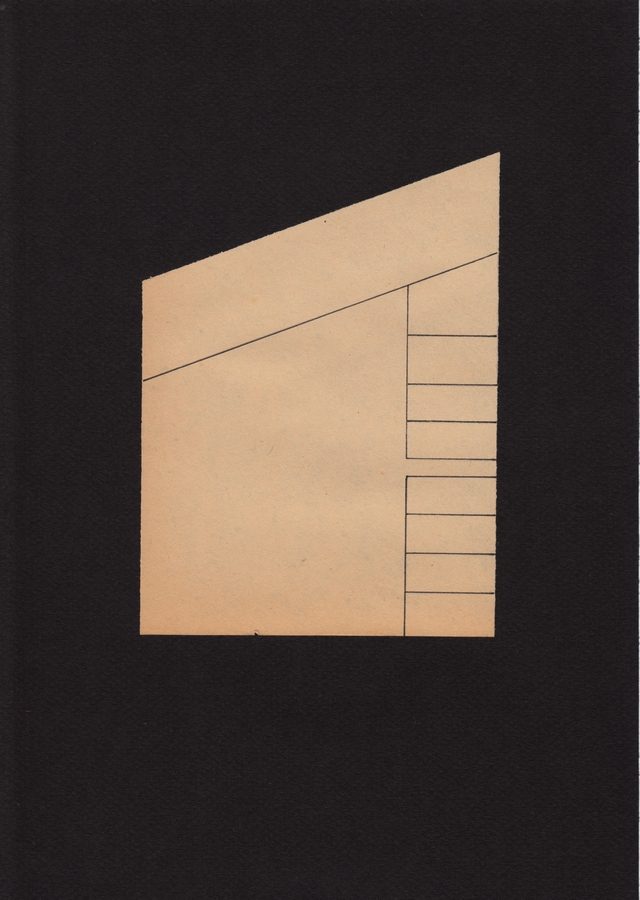
Vintage Paper and Ink Collage on Paper. Edition 3
This collage was made using archival architectural records of Johannes Itten’s art and architecture school in Berlin, Germany. It is based on a work entitled Konstanzer, 14 Garages from my Bauhaus series that represents buildings where members of the Bauhaus Group lived and worked before 1933, when the Nazi regime forced the school to close. For this series – as with my Exiles series – I use old, found and sometimes damaged paper, to echo the pages of the archival files and bound books that provide me with my source material. Through architecture, the work is concerned with identity, place – and a culture’s loss both of individual citizens and of a creative tradition.
800 € net
unavailable
Hand drawings on Paper. 3 unique works
Drawings for sculpturedresses.
Two examples [lines and squares] available.
250 € net
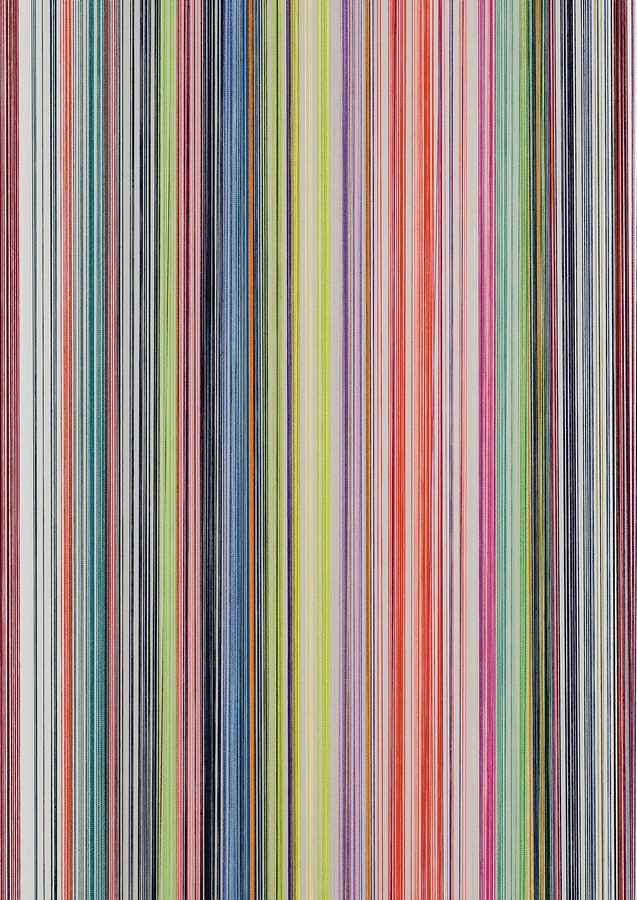
Inkjet print on Cotton Radiant White 270 gr. 12 + 3 E.A.
The work is a print, after a photograph of a detail of my sculpture “(Not) Connecting”, 2008. Thought as homage to the German designer Lilly Reich, the 10 metres long sculpture, made with the full color spectrum of Gutterman’s silk threads, and pulled taught between two wall–mounted brackets, forms a minimalist color study: the solidity of the threads pulled tight transmute the materials – the “limp threads”, as Anni Albers once characterized them – into a vibrant block of color, that in its formal and minimal purity relates to the forms of both modernist painting and architecture. This work brings about a crossover, or perhaps, better, unites – and we must not be afraid of the words – Modernism and Feminism. And this is in itself another redemptive force, given that the main thrust of the modernist movement was almost always through great masculine gestures. Collection by collection, thread by thread, another history is created here, one that is made up of gestures that are invisible and yet which are those that give the structure.
500 € net
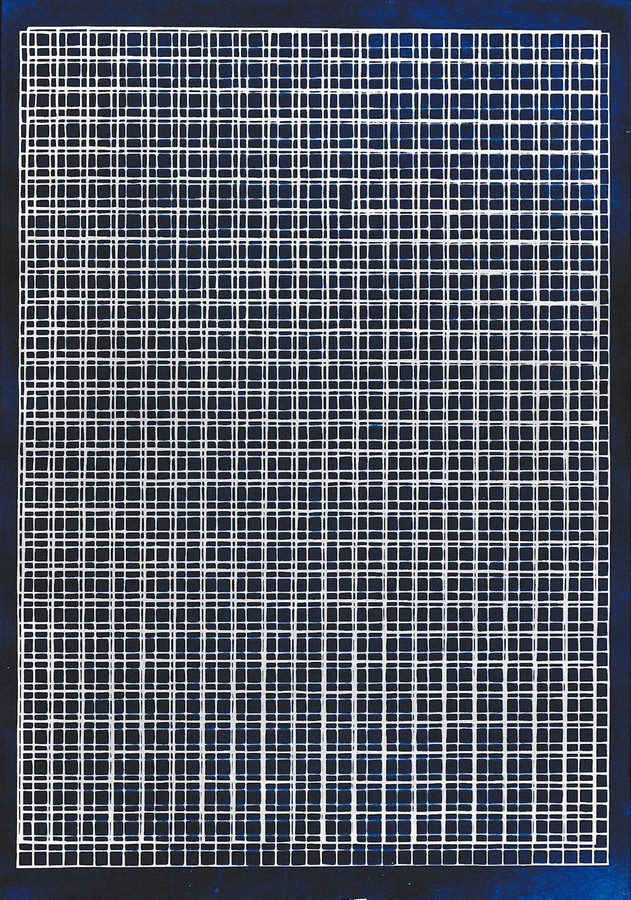
Cyanotype on paper. 3 unique works
Wiederholungen, serielle Strukturen und Raster sind Grundelemente von Fiene Scharps Papierschnittzeichnungen. Mit Skalpell trennt sie die Zwischenräume gerasterter Lineaturen aus dem Papierträger heraus, so dass lediglich filigrane Gitter bestehen bleiben. Zwei solcher ineinander verschobenen Papercuts bilden die Grundlage für die vorliegenden Fotogramme. Der manuelle Prozess des Schneidens und des fotografischen Entwicklungsverfahrens der Cyanotypie führen zu minimalen Ungleichmäßigkeiten der ansonsten strengen Gitternetze.
319 € net
One available
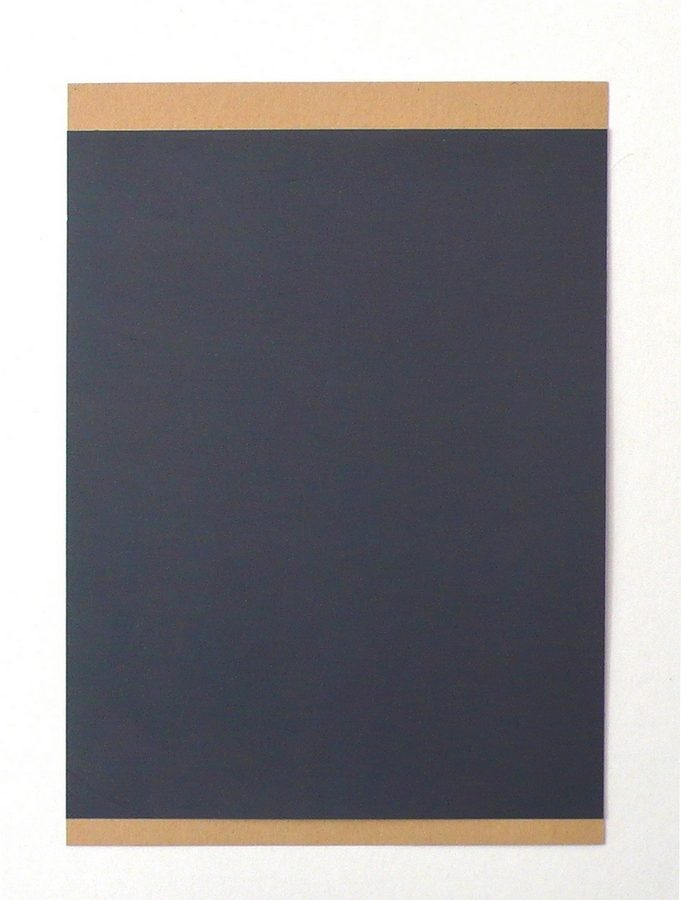
Screen print on colour paper. 30 + 3 E.A.
– full of emptiness – nothing and something –
300 € net
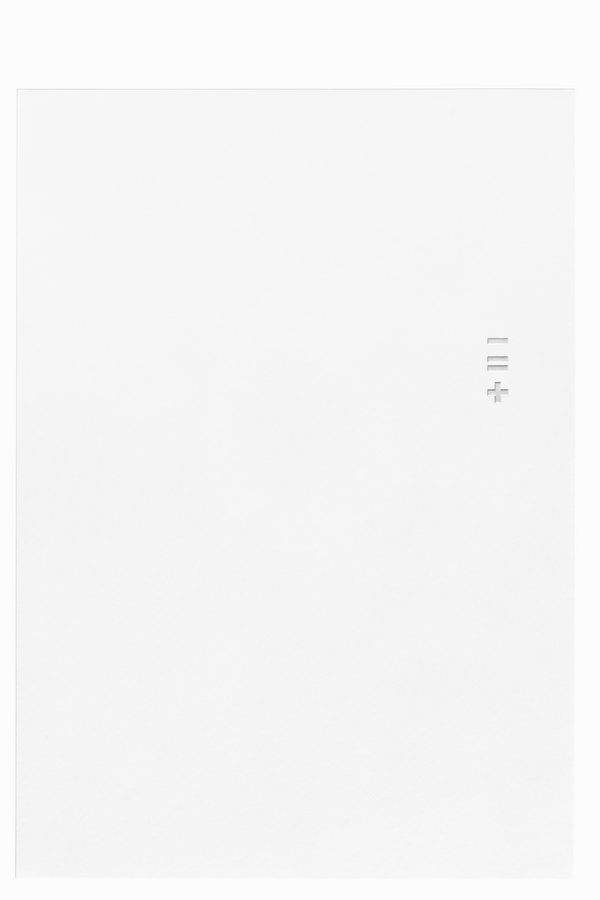
250 gr. Bristol Cardboard with blind embossing.
The Bauhaus concept of reduction certainly influenced me the most. Less is more.
180 € net
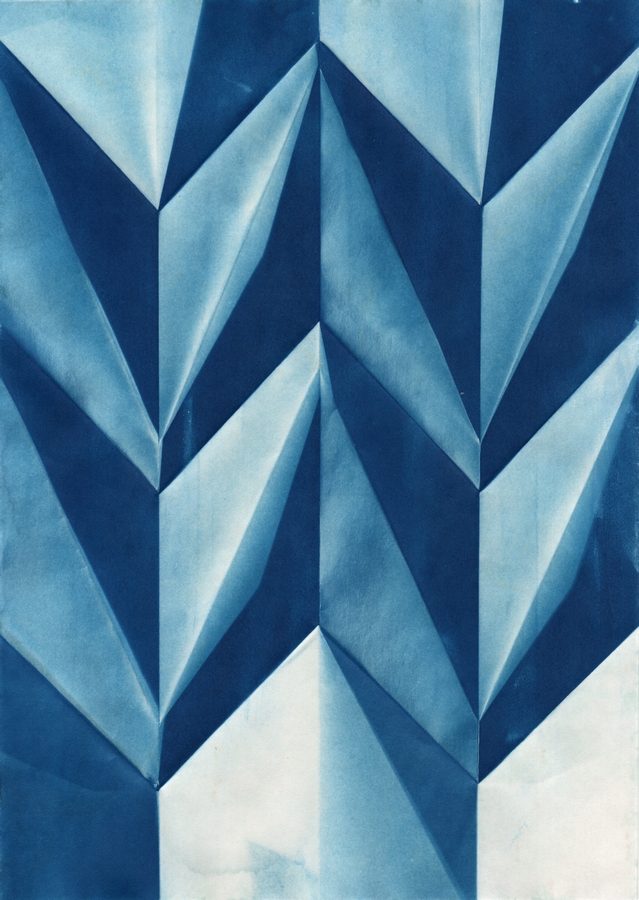
Cyanotype print on paper. 21 + 3 E.A.
I have applied a folding pattern to cyanotype–treated paper and then set it in the sun at such an angle that the folds create shadows. When developed, the areas that were shadows become white, while the areas that were struck by direct sun become blue. Paper folding was important facet of the Bauhaus Preliminary Course, teaching students a sensitivity to the potentials and limitations of a material. Photography was never formally taught at the Bauhaus, but was present in the work of instructors like Josef Albers and László Moholy-Nagy. I have brought paper folding and photography together in such a way that each informs the potential of the other.
800 € net

Papier-Skulptur, Karton verleimt. 9 + 3 E.A.
“aus dem rahmen” — Mit diesem Titel assoziiere ich den Aufbruch in eine neue gestalterische Demension – eine Veränderung des Gewöhnten. Ein Beispiel dafür ist der BAUHAUS-GEDANKE, der durch ein Lehrinstitut im 20. Jahrhundert wirksam wurde und noch heute eine grosse Bedeutung hat.
Available on demand.
420 € net
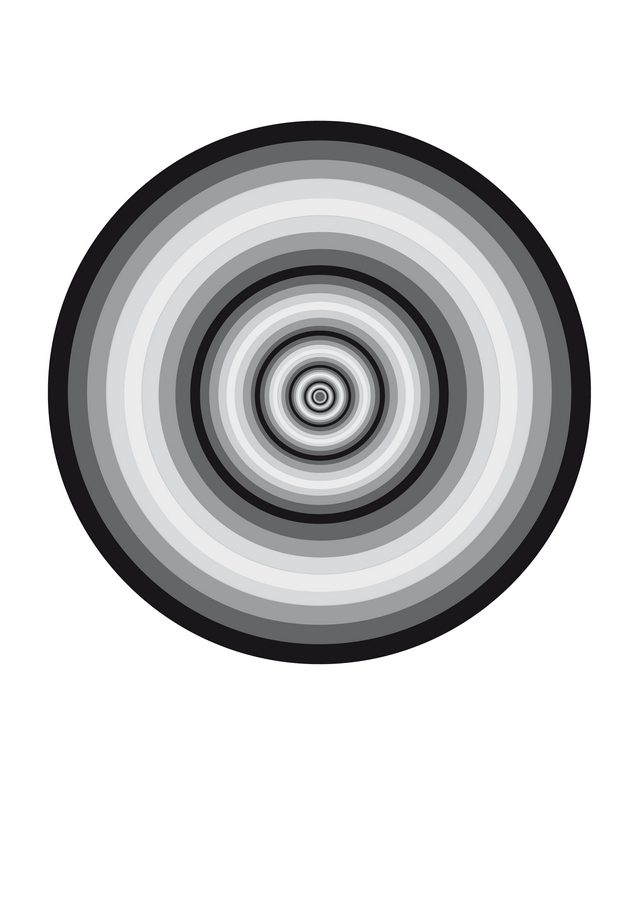
Digital Print on Cotton Paper. Edition 3
I’m working with the perception of space and motion, with the goal of capturing time, as music captures time. This piece is unusual for me in it’s reliance of tonality, creating an effect of polished metal.
200 € net
Unavailable.
Kugelschreiber auf Papier. 3 Unikate
Die Herausforderung [Projekt CENTURY], das Narrativ Bauhaus [DER NEUE MENSCH, DAS NEUE SEHEN].mit zeichnerischen Projektionen auf kleiner Fläche zu fassen, scheint eine Zumutung. Als minimalistisch komplementäre Entsprechung der Diversität des Bauhauses aber konsequent. Eine auf das Äußerste reduzierte Anmutung, die zu exemplarischen, geometrisch konkreten Interventionen einlädt. Zu sublimen Aneignungen, Fragmentierungen, Eingriffen. Annäherungen an eine Idee. Der bauhausgeschulten Wahrnehmung werden Irritationen zugemutet. Die erwartete Gesetztheit wird minimal dekonstruiert. Das vordergründig Stabile, Gefügte gerät in unscharfe Bewegungen. Die geometrische Ordnung wird subtil verlassen. Unrechte Winkel. Sacht fallende, aufsteigende Linien konterkarieren die Waagerechte. Sich neigende, kippende Ränder bewirken eine Atmosphäre vertikaler Verklärung. Die Parallelität ist außer Kraft. Erwartete Kontexte sind unterlaufen. Dezente Eingriffe irritieren. Eine diskrete Störung der Sehordnung [Marcel Broodthaers: Poesie als Störung von Weltordnung]. Ein konzeptionelles Unbehagen zwischen nüchterner Konstruktion und poetischer Ernüchterung. Der Bezug in der Haltung, dem abgestimmten Maß, bleibt als Anordnungsnotwendigkeit evident. Keine falschen Versprechungen. Keine gefällige Verklärung. Ein abgesetzter Horizont von Einfachheit, Strenge und Harmonie. Und ein Moment der Melancholie. Ein Moment der Flüchtigkeit, des Abschieds. Das gehört auch zu dieser Idee Bauhaus. Aber die Gegenwart braucht das statuierte Exempel Bauhaus. Denn die Dimension der Zumutung darf nicht abhandenkommen. Unter globalen Vorzeichen drohen maßlose Konformität, Terror des Gleichen und Austreibung des Anderen [Byung-Chul Han, 2016]. Mit elementaren Mitteln das Singuläre stärken, vitalistische Projektionen anstoßen, generieren. Jenseits vertrauter Codes. Jenseits der Fülle. Überschreitungen ins Fremde, Untiefe denken, wagen. Einen Raum der Nicht-Gewissheit betretend. Das SEHEN DES ANDEREN im Sinn. Gegen den Zeitgeist das Schöne verteidigen!
950 € net
Only one monochrome work available
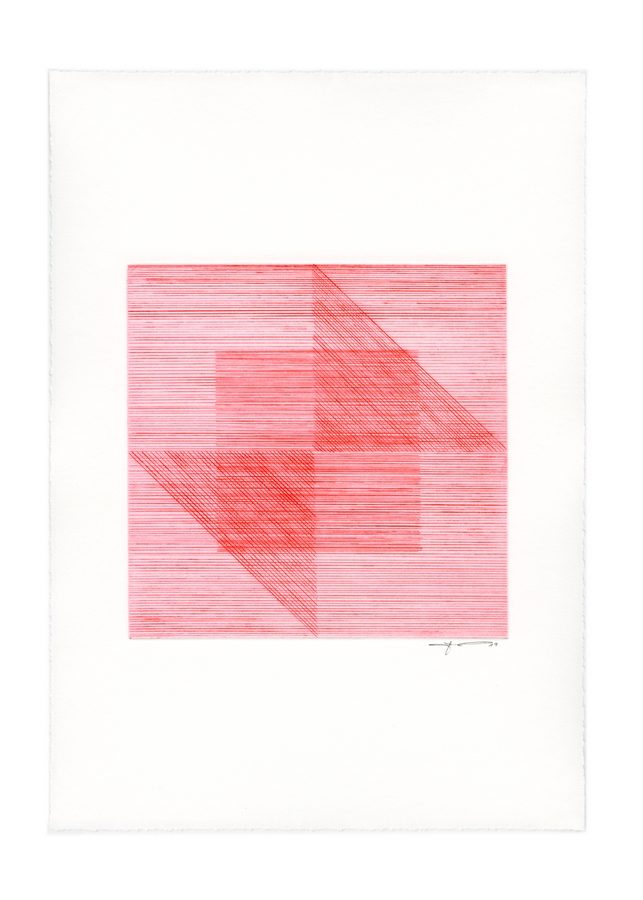
Etching on Cotton Paper. 4 + 2 E.A.
I am very much inspired by the Bauhaus passion for simple geometry. “When lines, squares and triangles meet” is a cold needle etching, starting with a red square which refers to the idea of Johannes Itten and Wassily Kandinsky to assign colors to a geometric shape. The image is based on the one color, which changes with the presence, effect and intensity of the line..
180 € net
Unavailable
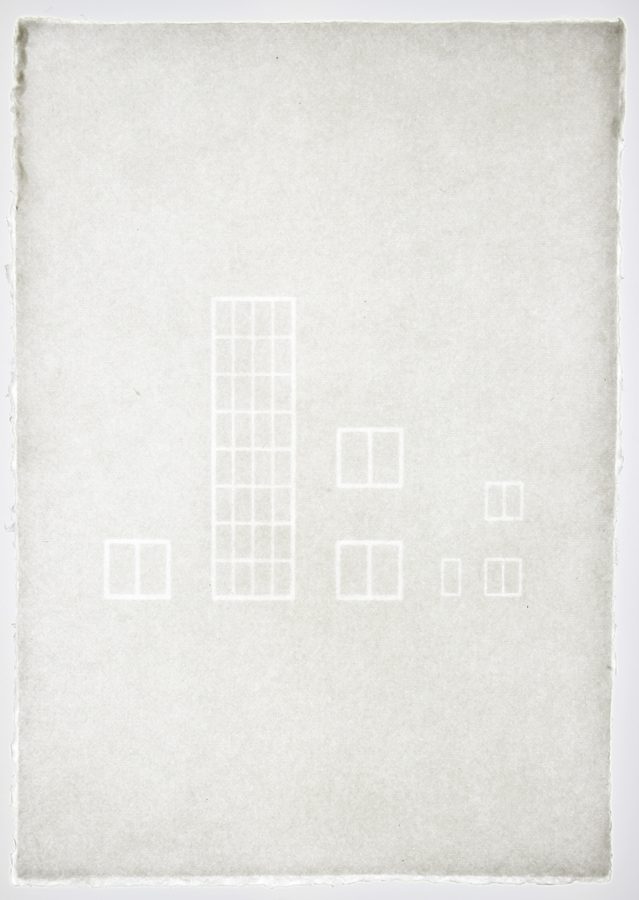
Handmade paper with watermark. 40 + 3 E.A.
This is a line drawing showing significant windows of the Meisterhaus Kandinsky / Klee seen from a Northern position. The drawing, however, is “hidden” in the structure of the paper as a watermark. Hold the sheet against the light and you will see it most clearly. Without additional light or a darker background the sight vanishes to a degree of little visibility. Have the ideas of the Bauhaus become so omnipresent that we do not recognize them anymore?
300 € net
Collage aus Foto-Negativaufbewahrungskarton und Pergamintasche auf Finnpappe. 3 Unikate + 1 E.A.
Vorfabrizierte, zeitgebundene Gebrauchsmaterialien der Kunst werden in einen anderen Kontext gesetzt. Eigentlich zur Archivierung künstlerische Arbeiten auf Dia- oder Negativfilm genutzt, sind sie heute in einem neuen Zusammenhang Utensilien der Kunst an sich geworden.
Unavailable
Cotton fabric and thread stitched on cotton paper. 3 unique works
I work with textiles and enjoy using materials and techniques that are associated with crafts to push the boundaries of fine art. My Field Notes series came from a desire to create a body of works on paper. Each one is made out of small pieces of commercially sourced woven cotton fabrics that I stitch together with a sewing machine and then press with an iron, using the same techniques that are used in industrial and home sewing. The compositions of simplified forms in this series are created improvisationally and design decisions are often made in the moment as I am working on each piece. Once the composition is finished, I stitch it to paper with the sewing machine, and the edges of the fabric are left raw and untouched. These pieces serve as studies, although they are finished works in and of themselves, and each one is unique. The loose thread and frayed edge of the fabrics are intentionally left as such, as they reference and honor the beauty found in everyday items used in domestic settings. My work is influenced by many of the artists and teachers of the Bauhaus, but most notably by Josef and Anni Albers. I am forever indebted to Josef’s exploration of color and his studies on their interaction, and I reference that in all of the work that I produce. Anni’s textile work is most special to me, as I revere her as a pioneer in the world of textiles and particularly in pushing the boundaries between art and craft with her designs.
400 €
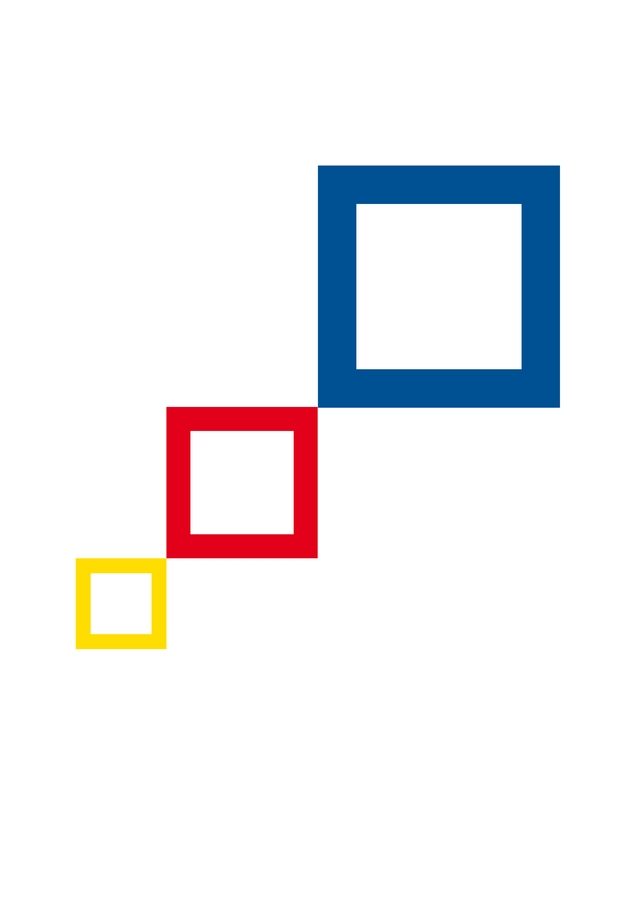
Digitaldruck auf Papier. 21 + 3 E.A.
Bauhaus steht für mich für Logik, Klarheit, Funktionalität und Aufbruch zu einem neuem Denken.
130 € net
Künstler-PC-Print auf Bütten. Je 2 Exemplare
Blatt 1 + Blatt 3 ergeben Blatt 2
1.000 € net for all 3 sheets
Unavailable
Tempera on paper. 3 unique works
The new abstract works of painter Ioannis Lassithiotakis follow up from his previous work, which was titled ‘The Black Line’. The black line, a symbol of immobility, limits and authoritarianism, in these new works meets the top of the tower of life and death, touches the vertices of the triangles of vanity and ascension, is immersed in the yellow of memory and time, it becomes God’s point of view. The constructions of stable or sometimes unstable equilibrium it sets up in combination with standard geometrical shapes, undercut the stillness of the black, yellow and white limits, inducing us into a deeply political, existential and ultimately philosophical dialogue with the abstract works of art. The paintings, which can be placed within the traditions of Suprematism and Minimalism, are very simple in their expressive elements but at the same time very dense and enigmatic in their content. The monochromatic blocs that dominate the two–dimensional compositions initially appear to allude to familiar symbols, but, on a second reading, they seem to pose questions rather than provide answers, through a process of enquiry, juxtaposition and emotional and conceptual stimulation. Some of the larger paintings depict colored box–like figures. These seem to be carriers of messages, symbols of ethnicity, of displacement, but also of establishment, dominance and repression. The boxes are positioned in a way that creates multicolored columns, in stable or unstable equilibria, rendering the frame a space where the established ideologies and their antagonists continuously play out. In some of the works the parallelograms, apparently carrying symbolisms of color, look like ballot boxes – immobile, pregnant, but traumatized by a straight slit on their bodies. Elsewhere triangles, yellow, red or black, terminating at the final black line, can be taken as symbols of the human life–voyage, forward to the future, but still full of incertitude, vanity, and always tragically terminal. However, the black line is often crowned by a white or yellow horizon, giving the works an existential optimism and inviting us to meditate on what lies beyond the limits. But in his enigmatic work “God’s Eye”, the artist places God’s point of view decidedly within the limits (of life itself? of society? of the world?), disturbing the geometric balance of the composition and the chromatic harmony between white and yellow. The new work by Ioannis Lassithiotakis brings back to the forefront the metaphysical as well as sociopolitical dimensions of abstraction in a resourceful and modern way that builds in a creative way on the vision of the great avant–garde artists of the 20th century.
Harris Hatziioannou, PhD, Philosophy
Two still available.
1.200 € net
Watercolours on Arches paper. Series of 5 works
Pirelli Tire Building by Marcel Breuer, the Marianne Brandt ashtrays and Farbkreis / Farbkugel by Johannes Itten were my reference points for this
series. I was interested in the juxtaposition of information and non-information.
Red and Yellow works available.
600 € net
Gouache on Cotton Paper. 3 + 1 E.A
Die Serie von Gouachen habe ich mit einer japanischen Ise–Katagami (Papierschablone zum Färben von Stoffen) schabloniert. Die Ise–Katagami hatten ihre Blüte in der Edo–Zeit (17. – 19. Jhd.). Bei den Samurai waren besonders aufwändige kleinteilige geometrische Muster beliebt. Mich haben diese abstrakten Muster, die lange vor der westlichen Moderne entstanden, sehr fasziniert und ich habe ein paar Katagami auf dem Flohmarkt in Kyoto gefunden. Durch Überlagerung der Schablone entsteht aus einem Raster eine komplexe dynamische Zeichenfolge. Wichtig dabei ist die handwerkliche Machart, die Schablone ist handgeschnitten und mit dem Pinsel schabloniert, dies bedingt Fehler und Abweichungen. Die Gouachen erinnern an gewebte Textilien. Weberei und Flechtmuster sind uralte Handwerkstechniken, die aufgrund ihrer Herstellung in einem rechtwinkligen Raster seit Jahrhunderten mit geometrischen Mustern arbeiten in den verschiedensten Kulturen. Ich denke, die Moderne in Europa und die abstrakte Kunst haben zahlreiche Inspirationsquellen in außereuropäischen Kulturen. Mit der Entstehung der ethnologischen Sammlungen und Museen, den Weltausstellungen und Publikationen am Anfang des 20. Jhd. wurden Arbeiten anderer Kulturen sichtbar. Die Offenheit des Bauhauses und die Rückbesinnung auf das Handwerk als Quelle der Gestaltung schafften den Boden für diese Einflüsse. Dabei dürften einige Bereiche der hochentwickelten Handwerkskunst Japans für das Bauhaus interessant gewesen sein, da sie ästhetische Ideale des Bauhauses, wie Einfachheit und Funktionalität, den bewussten Einsatz von Material – diese Art von Schönheit, paradigmatisch umgesetzt hatten.
One work available.
600 € net
Handmade paper, pencil, metal. Series of 4 unique works especially for CENTURY. idee bauhaus
BAUHAUS evoziert verschiedene Assoziationen. Sie bilden den Ausgangspunkt für meine Arbeit BROKEN SQUARE für dieses Projekt. BROKEN SQUARE ist für mich ein Symbol für Alterung und Verfall. Ein Status, dem ein Umbruch folgt zu neuen Formen der Kreativität und Synergie.
BAUHAUS evokes various associations. They form the starting point for my work BROKEN SQUARE for this project. To me BROKEN SQUARE is a symbol of aging and decay. A status followed by a change to new forms of creativity and synergy.
Black example still available
600 € net
Paper collage. Unique works
The works started as method for sketch designs for three dimensional works. The colourful curves represent the sides of spatial paintings, which in the final linen execution can only be seen from an angle. In these spatial paintings seen from the front, one only notices the monochrome curved surface and just the shades from the sides The sides themselves are nonpainted linen. The paper works focus on possible slopes for the sides in a two dimensional representation ass well as that they open up a more free use of color and somehow introduce a kind of Matisse like lyricism to the otherwise geometric shaped works. Like Matisse it’s drawing with colored shapes instead of lines.
700 € net
Yellow and blue works available.
Silver gelatin process, bw baryta photopaper. Unique works
For this project, I work with a basic architectural structure of weight and support, process of surrounding a core, filling up a given space, finding proportions etc. I work with photo chemicals directly on the surface of photo paper, with tape and brushes, in a quite painterly way. There is no negative. The works are not prints. The whole paper is worked on under light, no dark room, it is lit evenly allover. The colour differences (of bw paper) are caused mostly by different concentrations of a developer liquid. Single works are variations on one composition. I am not interested in exact repetition, I do not measure, every work is started again anew and made as a live process, including mistakes, errors (stains, tearings etc…). I have a certain plan and expectations before I begin, to try to obtain certain hues and colour combinations. But, as the paper is totally overexposed, I do not see real, final colours until the whole thing is put in fixer, washed and dried. I like this combination of plan and chance. A combination of an attempt to put something in order and an impossibility to manage how the process would end up. Unexpectability within exact form. Colour appearing on bw photo paper. I was thinking about colour theories (Albers), which go through some organic, erratic process. I also was thinking about how perfection of Bauhaus’ ideas inevitably merges with features like materials’ aging (yellowing paper, fading etc…), changing how we perceive particular objects now, as visual information. To look at these three works as if they were bad (faded, failed) reproductions is ok, too. I like the uncertainty arising from the strange detached colour scheme – can I believe that these are what they are on them own, or are they a fading image of something else? A4 is a bit difficult for me to deal with. So, first thing I did with every paper was to make the format shorter – hence the white stripe on the bottom. It is not part of the composition, but at the same time it is, because it makes it fixed in certain position on the A4 format, as if on a book page.
Currently all produced pieces sold. Please contact us for details.
1.000 € net
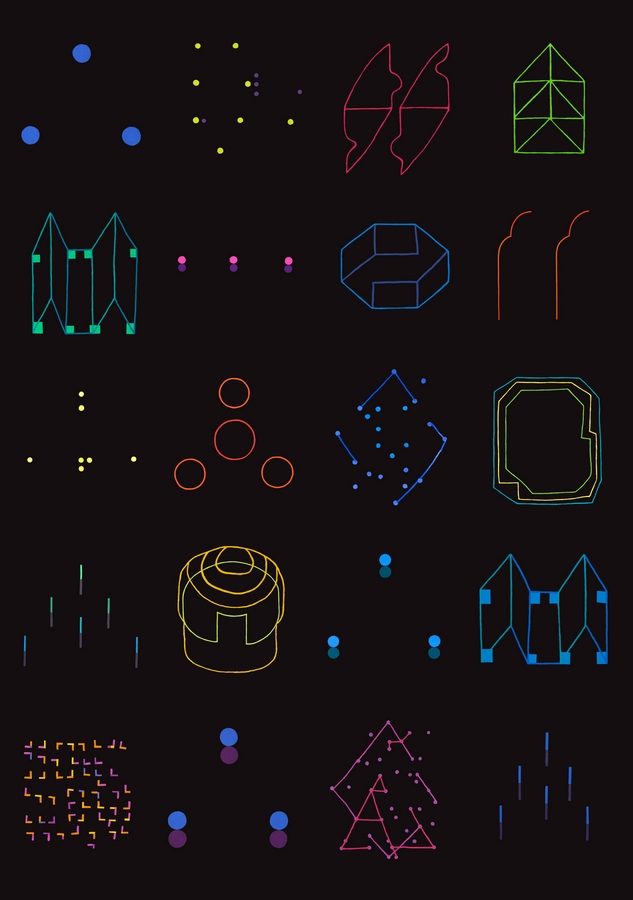
Digital print. 20 + 3 E.A.
The lineage and influence of the Bauhaus has travelled far and wide. When I was an undergraduate student at Pratt Institute in Brooklyn in the 1990s I studied with a professor, Herbert Beerman, who had been a student of Josef Albers at Yale. Herbert was a charismatic teacher who presented rigorous fundamentals of color and design, while also lecturing about psychedelics. The course had an element of anarchy, and project due dates were vague. Through Herbert and at Pratt, I was exposed to Albers, the Bauhaus, and to broader modernist projects. I became further immersed in abstraction and the concrete elements of art-making. I was also living in Brooklyn during what may now be considered a golden era of hip hop coming out of this locale. This music, the noisy energy of the city, and the bright commercial signage were impressing themselves onto my body and into my visual language. The Bauhaus was an exemplar of two important threads of modernism. Firstly, the Bauhaus helped to establish a kind of school of thought for artists to deal with the internal components of art-making, the inherent elements of line, form, color, structure, and so on. It “extracted” artmaking away from the world; it reduced and focused its principles. At the same time, the Bauhaus school connected abstract principles back to the real and applied world, through its collaborative investigations into industry, architecture, graphic design, furniture, among other spheres. This tension between art’s removal from the world and its deep engagement in it has been central to my evolving language. In April 2018 I had my first solo exhibition of paintings in Germany. A review, written by Monika Werner Staude and titled „Vom Überleben im Lauten New York“ appeared in the West German newspaper. The writer described how the work mimicked the sonic qualities of the urban environment in which I reside. She also stated that the work is quiet, distilled, and meditative, perhaps in response to this same noise. This piece was made by combining painted elements with digital editing
tools.
300 € net
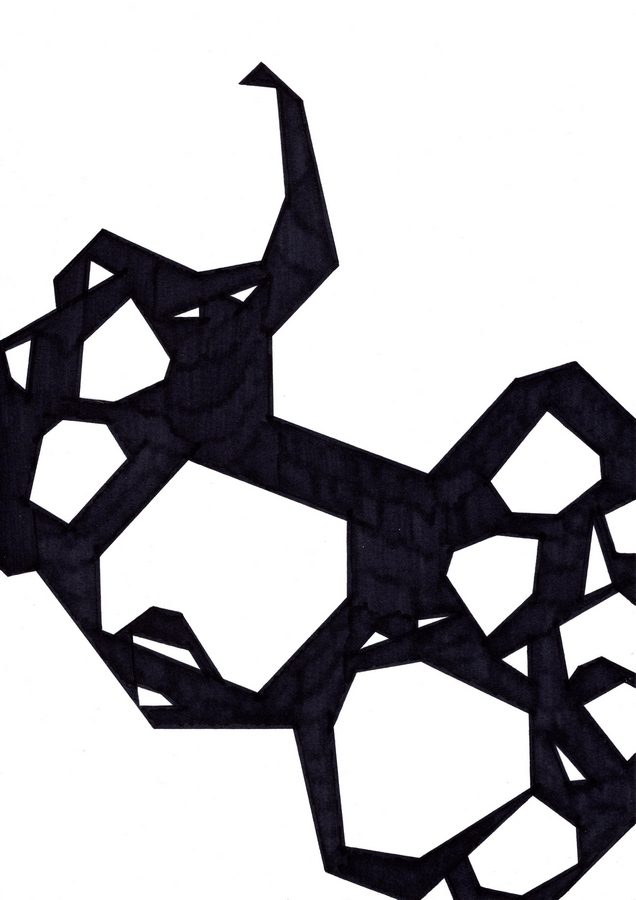
Permanent marker on Canson Paper.
Bauhaus is about universality. It (therefore) is international, spreadable, multipliable and applicable. My work is all about that, in the way it grows and merges on walls (wall paintings) or spreads as (multiple) paintings, prints and drawings. Also I think that international artistic collaboration in group projects is interesting and fun. The way art works mix can provide a big added value.
150 € net
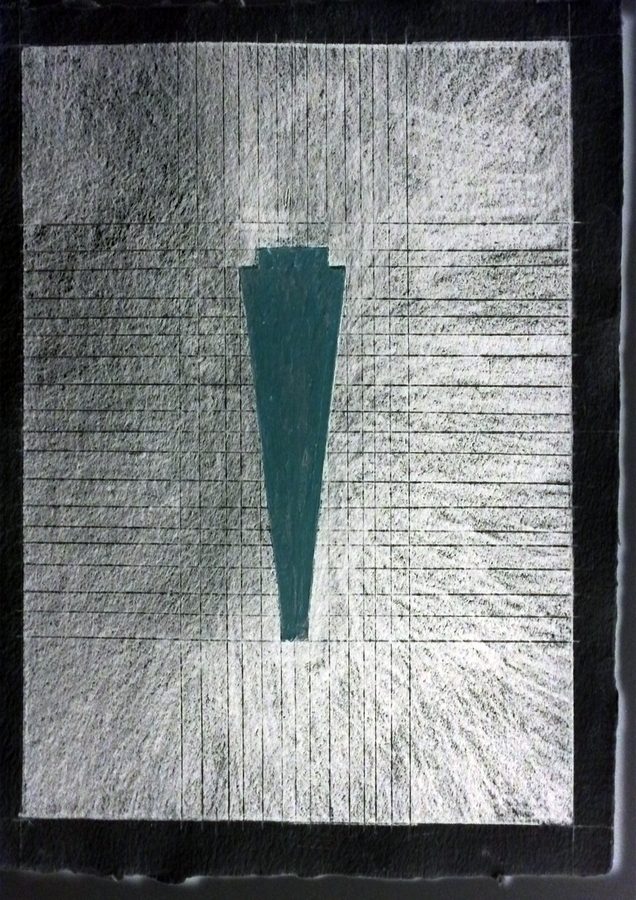
Metallic C–Prints on photographic paper. Edition 5
this drawing was created with a compass and straight edge according to the sq of 2 progression and then the aspect ratio changed to DIN A4 size [29.7 x 21 cm].in photoshop along with some other digital manipulations. I’m responding the shift in dimensions that I understand to be part of the bauhaus era when building materials were available in standard manufacturing sizes rather than as materials of varying dimensions, which were determined by the properties of the material itself.
150 € net
Acrylic and pencil on grey cardboard. Titanium white / Ultramarine blue / White, mixed with burnt sienna, yellow, red. Series of unique works
It might have been possible in terms of time, but I never have met Anni Albers. Fortunately I got to know her groundbreaking work, especially when I was artist-in-residence at The Josef and Anni Albers Foundation, in 2011. Looking at the work of Anni Albers is seeing her way of thinking through about materials, new forms and techniques. I admire her open mind to develop the work as far as possible, her courage, and write a Letter to Anni.
650 € net
Digital Print on Paper. 3 x 7 + 3 E.A.
One square, one triangle and a circle – this work consists of three parts. Only the distorted background of these forms is questioning their origin. I took a photo of a red, a yellow and a blue drawing paper in A4 format arranged on the grey squared ground of my studio. Using the transformation tools of image processing, I formed the three basic Bauhaus forms out of these rectangles. A fundamental thought of this work is how the use of computers over the last decades has changed our life and work. For me, the most interesting aspect in doing „shaped shapes“ is that a form was forced into another and now claims to be that form.
70 € net
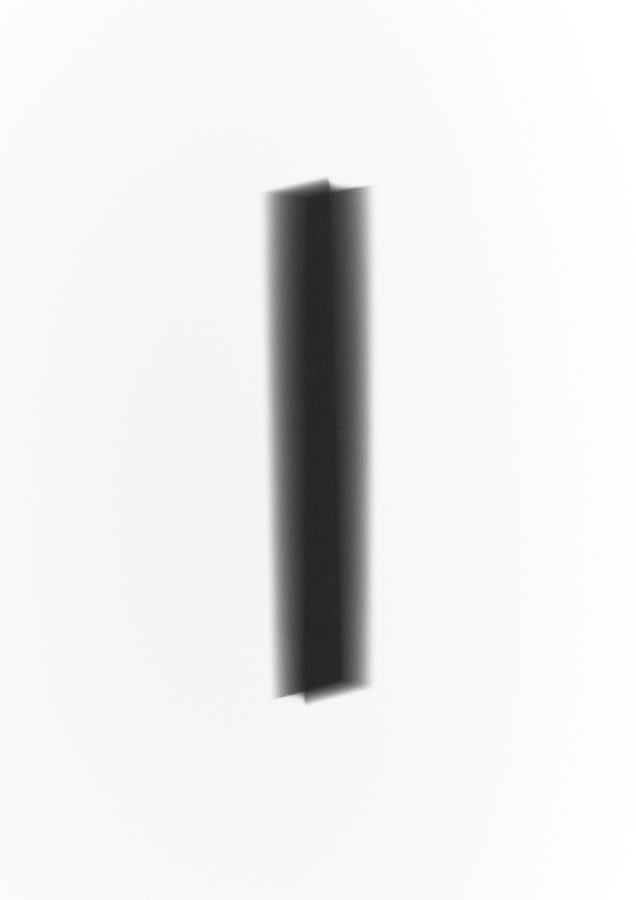
Luminogram on silver gelatin paper. 3 unique works
Das Luminogramm ist mittels eines Instruments entstanden, das ich im Laufe der vergangenen Jahre ent-wickelt habe. Ein Instrument zur Erzeugung von klingendem Licht. Ursprünglich wurde es für großformatige Lichtinstallationen in Ausstellungsräumen konzipiert. Es besteht aus einem Apparat, der gebündeltes Licht durch ein kleines Objekte fallen läßt. Das Objekt wird dabei durch einen elektronisch erzeugten Ton (Sinuston) in Schwingung versetzt. Durch diese Schwingung wird das austretende Licht moduliert. Mit dem Luminogramm wird das so entstehende Lichtobjekt gewissermaßen aufgezeichnet. Es trifft in der Dunkel-kammer auf lichtempfindliches Silbergelatinepapier. Bei dessen analoger Entwicklung tritt langsam die Spur hervor, die das modulierte Licht auf dem Papier hinterlassen hat. Durch die Schwingung entsteht eine räumliche Form, entstanden aus klingendem Licht.
950 € net
Unavailable
Polyesterfaden auf Aquarellpapier 300 gr. Je 3 Unikate in 6 Farben, neben den Grundfarben Rot, Blau und Gelb noch Orange, Grün und Violett
100 Jahre Bauhaus – 100 m Polyesterfaden. Eine Homage an die Frauen des Bauhaus. Obwohl Walter Gropius Gleichbehandlung als Maxime ausgegeben hatte, wurde Frauen die Textilwerkstatt gewissermaßen zugewiesen. Über fünfzig Jahre ließ Anni Albers Arbeiten mit Fäden entstehen. Sie webte Gemälde, Industriestoffe, ja sogar Denkmäler und brachte das Dilemma auf den Punkt: “Wenn eine Arbeit mit Fäden entsteht, dann wird sie als Handwerk betrachtet; auf Papier wird sie als Kunst angesehen.” Meine Arbeiten sind Fäden, genäht auf Papier. Kunst also. Die konstruktive Farbenlehre des Johannes Itten habe ich genutzt. Die Farben der ersten Ordnung sind Gelb, Rot und Blau, die Farben der zweiten Ordnung sind Orange, Grün und Violett. Eine Rolle Nähgarn enthält 100 m Faden, den ich, so eng aneinander und so gerade und ordentlich wie ich es konnte, auf 300 mg dickes Aquarellpapier nähte. Dabei musste ich feststellen, dass, je heller das Nähgarn ist, desto weiter die Nähte auseinander liegen. So füllt Gelb das ganze Blatt und am Ende musste ich die Nähte sogar noch übereinander nähen, während Blau und Rot jeweils noch einen weißen Rand Papier sehen lassen.
750 € net
Linoldruck auf Fine Art Print auf Papier. 3 Motive + je 1 E.A.
Die Arbeit basiert auf Fotos, die durch google bei der Eingabe des Begriffs ‘Bauhaus’ gefunden wurden. Die Fotos decken dabei drei verschiedene Bereiche ab: Das Gebäude des Bauhaus selbst, ein realisiertes Projekt (Das Denkmal für die “Märzgefallenen” von Walter Gropius aus dem Jahr 1920) und den Menschen in Form eines Fotos einer Tanzperformance. Alle Fotos sind überarbeitet und aneinander angepasst. Überstempelt und dadurch teilweise unkenntlich gemacht wurden die hochwertigen Drucke anschließend durch einen Linolschnitt, der selbst wiederum an ein schwarzes, nahezu quadratisches Rechteck – eine weitere Errungenschaft der Moderne – erinnert. In einem weitere Arbeitsschritt wurde jedem Motiv eine Farbe zugeordnet. Der Druck erscheint dabei zunächst als abstraktes Muster, zu lesen ist aber auch der Text “PEREANT QUI ANTE NOS NOSTRA DIXERUNT” – etwa: Tod denen, die vor uns das Unsere sagten. Zugeschrieben wird dieses Zitat Aelius Donatus, einem römischen Grammatiker, der in der Mitte des 4. Jahrhunderts gelebt hat und der als Lehrer Augustinus‘ in Erscheinung getreten ist. Zitiert wurde der Satz oft und auch mein Gebrauch der Worte changiert ganz bewusst zwischen einem künstlerischen Neid (im Sinne eines Wettkampfs) und einer offensichtlichen Anerkennung der großen Leistungen anderer. Es stellt sich die Frage, inwiefern die eigene Arbeit immer auf den Schultern von Vorgängern steht.
Red and Silver printed works available.
450 € net
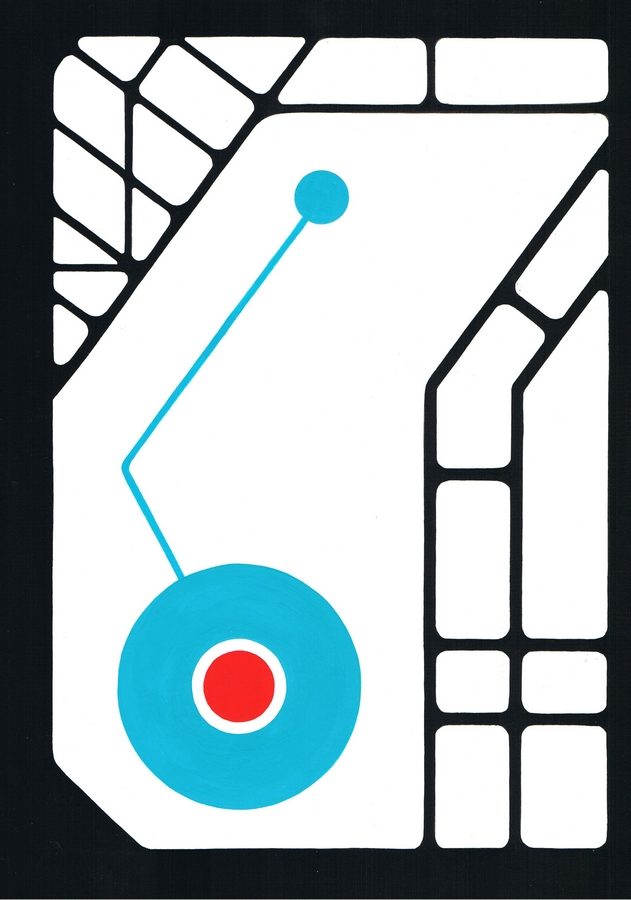
Gouache on Paper. Edition 3
Das Endziel ist der Bau, doch der Anfang ist die Form. Gib der Form ein Zuhause: Form ist Sprache. Form ist Inhalt. Gib der Form eine Farbe: Farbe ist Charakter. Farbe ist Ausdruck.
580 € net
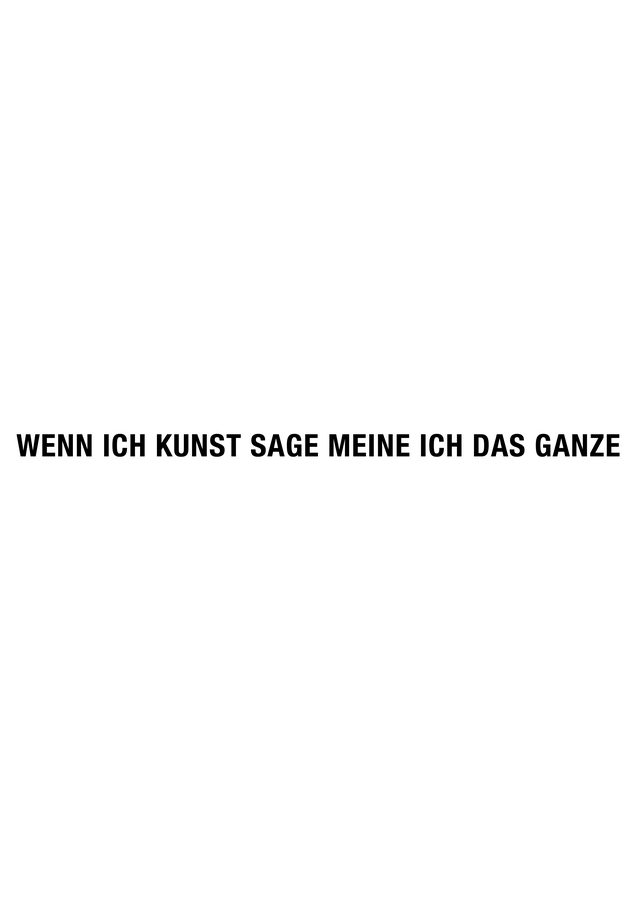
Digital Print on drawing paper 180gr. 20 + 5 E.A.
Ohne metaphysische Öffnung, ins Ganze eben, würde Kunst sich ja unweigerlich in den üblichen kognitiven Modellen und im Pragmatischen verlieren. Kunst ist kein verfeinerter Kulturindustriezweig. Kunst ist für nichts da. Für alles. Kunst spricht in den Wind, hebelt nicht herum. Beginnt genau dort, wo die Messbarkeit endet. Kunst ist eine unendliche Kugel, ihr Mittelpunkt ist überall, und Umriss ist keiner auszumachen. Wenn ich Kunst sage, meine ich das Ganze.
120 € net
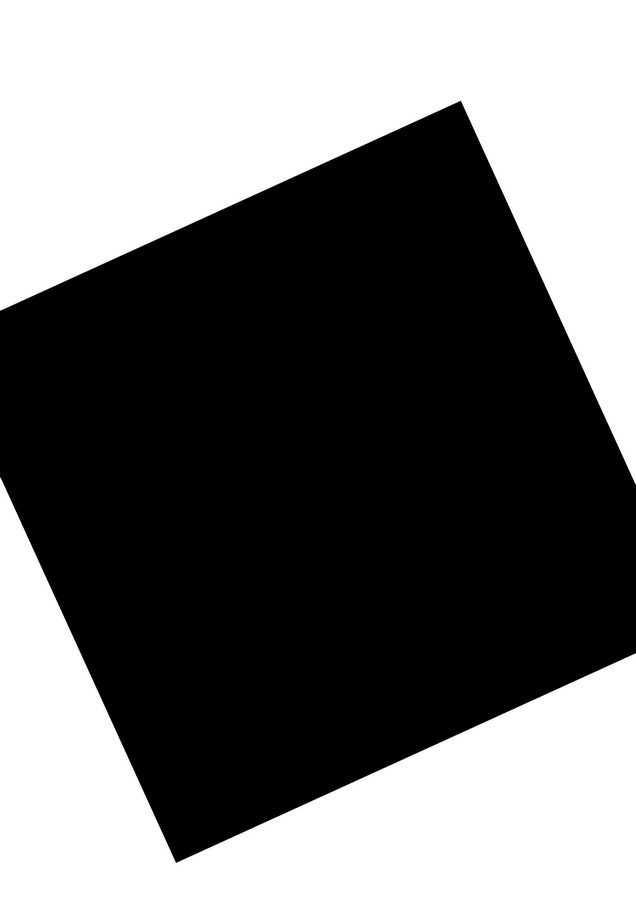
Siebdruck. Edition 10
300 € net
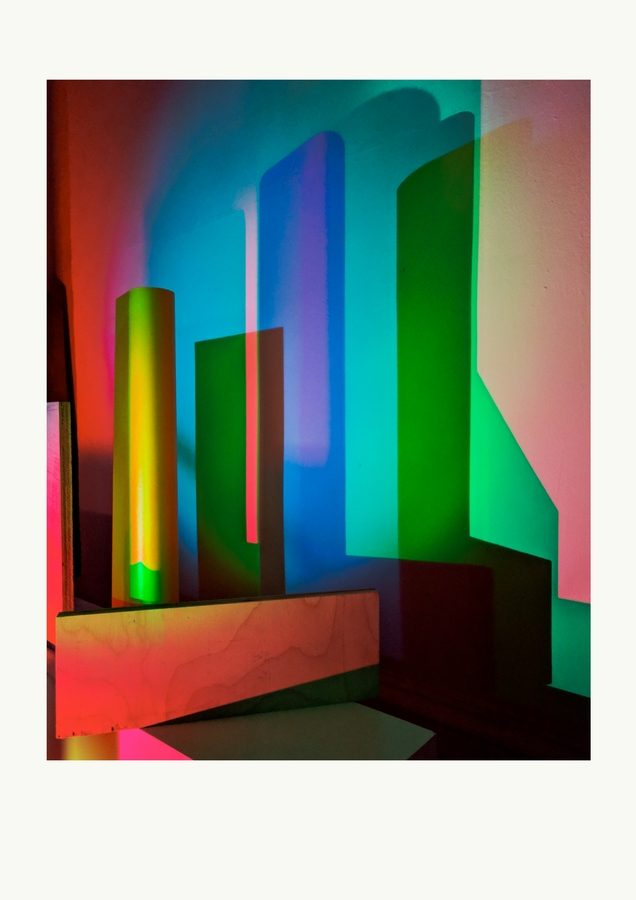
Archival pigment print on paper. 10 + 3 E.A.
I treat light as a material. With an analog approach rooted in the visual language of painting, I combine physical objects, light, and color in temporary, immersive installations that are integral to and inseparable from their architectural sites. These color spaces are luminous, temporary geometries, calling into question the divisions between analog and digital ways of seeing. My photographic practice began as a straightforward way of documenting these installations and taking notes on my working process, but photography is now a primary way for me to see and show color and ephemeral form. With simple geometric shapes made of wood and paper and an experimental approach to additive color mixing, this image plays with a cross section of Bauhaus principles: the study of form, material, color, composition, and space.
300 € net
Digital fine art giclée print with hand–painted additions, on Hahnemüle Photo rag 500 gr. 100% Cotton White. 20 uniques
Painting is one of the many media used to generate a work of art, to inevitably submit it to the law of change: everything mutates according to the position we assume towards it. We are continually subjected to dualism. I have chosen painting and geometry as the most simple and suitable instruments to paint stressing the importance of the sensibility of the hand, the tactility of pigments, the way light reveals their surface. Often painting that is based on geometry expresses the necessity of the individual to rationalize, but in my work geometry is a means of discovering unforeseen dimensions. Bauhaus has freed artists from a traditional sense of conceiving a work of art, it has given strength to the idea and freed every material from traditional use. Thus, “art” becomes any process applied to an element, to an object, to a construction. I have absorbed by osmosis this thought because I leave open the possibility of expanding my research by intervening with different materials and modalities, even the tridimensional aspect. The work presented here is originated from scraps of plastic stickers that I used to define areas of color on a D-Bond panel. I then glued the scraps on a sheet of paper distributing them in order to create structures and added to them by using pens and colored pencils, and painting with watercolors other areas. These are giclée digital reproductions on white paper. I have further added paint on some areas with acrylics or egg tempera, revealing the physicality of the work: the sheet of paper is not only support but also a perceptible surface the eye sees in diverse manners.
200 € net
Digital print edition of 3 hand drawings
From 2 to 324 on three variations are related to the ideas of “Point and line to plane” by W.Kandinsky. These are descriptive drawings in which all even numbers from 2 to 324 are drawn as sum of two prime numbers*. The three variations are the result of distributing the geometrical point of each number in three different organisation forms: linear, diagonal and spiral). *Prime numbers are those that can be divided only by 1 and themselves, they are the elemental blocks of number theory because every other natural number greater that 2 or 5 can be expressed as a sum of three prime numbers (uneven numbers) or as sum of two prime numbers (even numbers).
350 € net
Unavailable
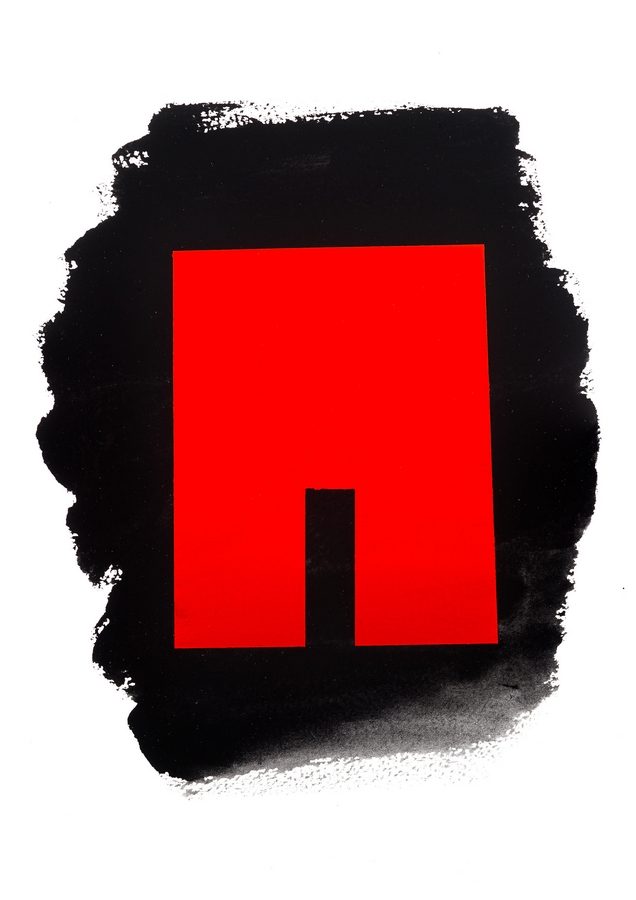
Giclée digital print. Edition 20
Bauhaus has given me a framework within which to fit my idea of art as an open field in continuous evolution. By never settling on one visual language alone I feel that I am expanding the concept of Gesamtkunstwerk that Gropius and Piscator were exploring. Instead of feeling it as a limiting canon, it allows me to cultivate the panic and excitement of never knowing exactly where the process of art making will lead me. Bau Tur is part of my more reductive group of works. Alone or mixed with other forms, a simplified portal has been a recurring motif in many of my paintings and installations. It reminds me of Mon the Shinto sacred gate, the stone entrance to Mycenae, the Pythagorean π.
300 € net
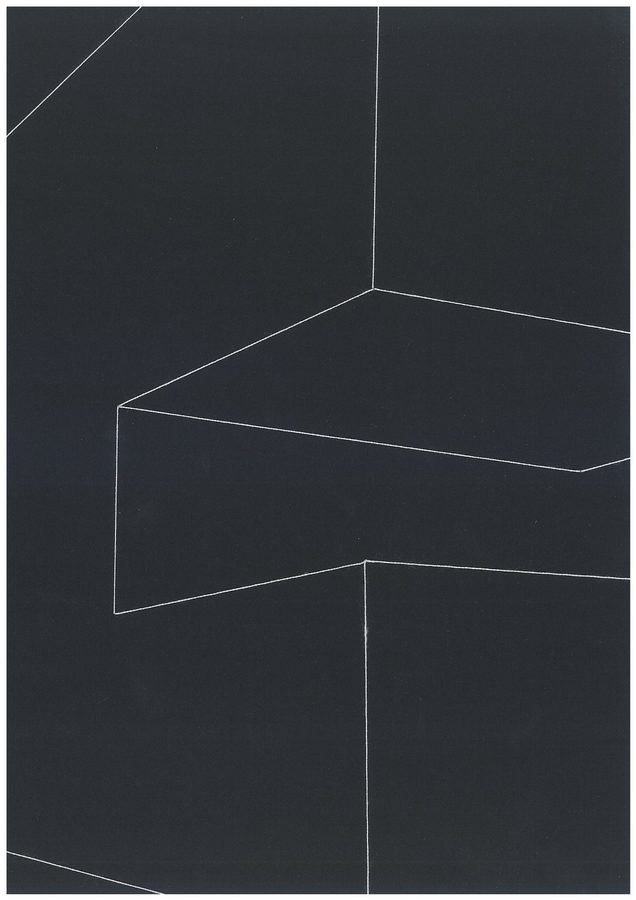
Thread on Cardboard. 5 + 1 E.A.
When I visited the Bauhaus in Dessau not long ago, I was excited to see the new Meisterhäuser buildings, that were built upon the ruins of the old ones that couldn’t be restored. I found the form of these houses quite an interesting choice for a context like Bauhaus, where everything is supposed to be light and well balanced. These buildings look rather heavy and solid and send out an almost provocative message in this environment. The windows are satined, so it’s not possible to see through them. The people working inside complained, that is not a nice working environment, because these buildings have a claustrophobic effect on them. For my contribution to CENTURY.idee bauhaus I worked with photographs of these new Meisterhäuser by drawing the outlines of these buildings at my computer and later zooming in these drawings. My goal was to create a work, that still partly shows the hole image and at the same time goes beyond the representation of this image. When I found the right balance in this process I transferred the lines to my favoured materials thread and a special kind of black fibre cardboard. Stitching the thread onto the cardboard is my way of combining the computer supported form shaping to the tactile materials of the Bauhaus. The title half reflects this process of partly showing something and invites the viewer to imagine a greater form outside the lines of the concrete surface.
400 € net
Gouache on tea stained paper. Unique works
Each series employs repetitious mark making as a means of meditative ritual. The works, intimate and small, reference journal pages and mimic handwritten text, yet divulge no decipherable meaning. Rather, the stitches, burns or dots act as a record of ritualistic creation, transforming each piece into a relic of touch.
480 € net
Unavailable
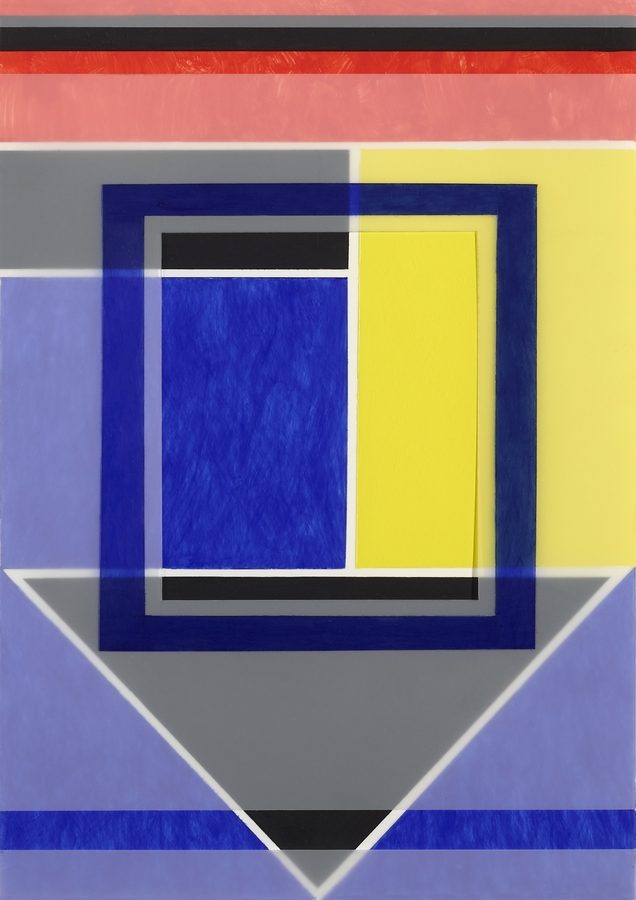
Transparentpapier beidseitig bemalt, gefaltet und geschnitten. 3 Exemplare
formspiele – spielformen. formen der vieldeutigkeiten. das haus steht kopf. die öffnung des ausgeschnittenen fensters gibt den blick frei in neue dimensionen.
550 € net
Ink, color pencil, acid-free non-tropical wooden paper. From a series of unique works
In The Pink Elephant in the Room Series, I use the formal language of lines, planes and geometry to address gender inequality and other issues such as representation in art history and in the contemporary art world using humorous active titles in which the “pink elephant in the room” makes herself visible. For this set of three drawings from the series, I use wooden paper as a substrate, placing The Pink Elephant in the woods, literally and metaphorically, but shifting the meaning towards making her path as she walks forth, fearless, mixing organic nature and geometry while engaging in the fraught territory of mixing metaphors. Drawn with Ink and Color pencil on Acidfree wooden paper, 29,7 x 21 cm.
700 € net
Two works available
Acrylic paint on paper. Series of unique pieces
My Slice, Punch, Dip series involves a dipping process to apply paint to a surface, which I began using a number of years ago. It was a way of working that gave me some distance from the subjectivity of the brushstroke. I was also searching for a process that was more physical in nature. Through this process, the paper becomes impregnated with paint, allowing medium and support to merge and become one. For this series, in keeping with the spirit of the Bauhaus, a template was used to laser cut circular holes in sheets of paper, making the works easily reproduceable. The “slice and punch” in the title, refers to my cutting of holes through the paper, thus further enhancing its physicality.
650 €
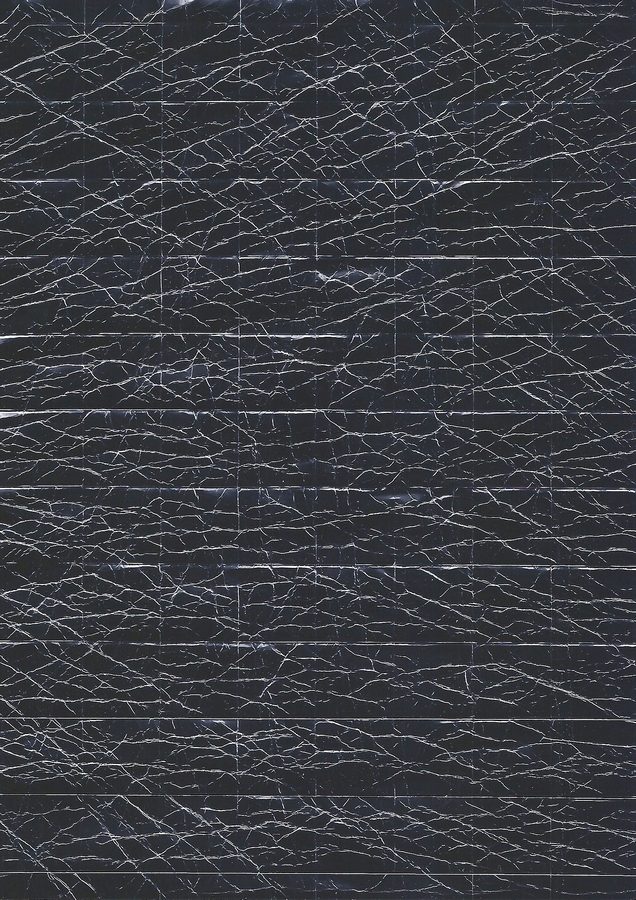
Scored and creased black mirrored paper. 3 E.A.
For the Century exhibition, I used a non-traditional drawing method on a non-traditional drawing material. I first scored an open-ended square grid with a bone knife into the surface of a black mirrored paper. I then crushed the paper with my bare hands over and over again until the rigid paper became soft and pliable, like a piece of leather. The surface of the drawing is reminiscent of my broken monochrome paintings that I make with a hammer on wooden panel. I wanted my drawing in this exhibition to appear like a frieze of shattered windows on Gropius’ Bauhaus building in Dessau. The windows are still intact, but under the weight of one hundred years of artistic and societal pressure, have fossilized into a sheet of mica crystals.
600 € net
Unavailable.
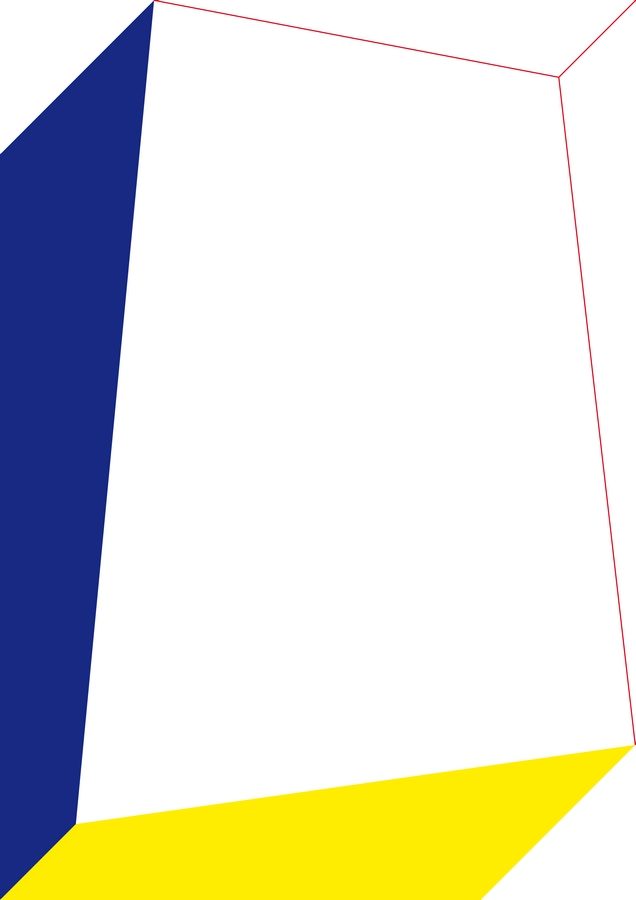
Collage and ink on paper. Edition 3
When I think of the Bauhaus I think of the basic principles of art – line, shape, colour, form and texture, and how these elements connect different creative practices. As homage to Bauhaus I wanted to explore different spatial aspects by using collage to produce an ambiguous yet structured space on the paper surface.
300 € net
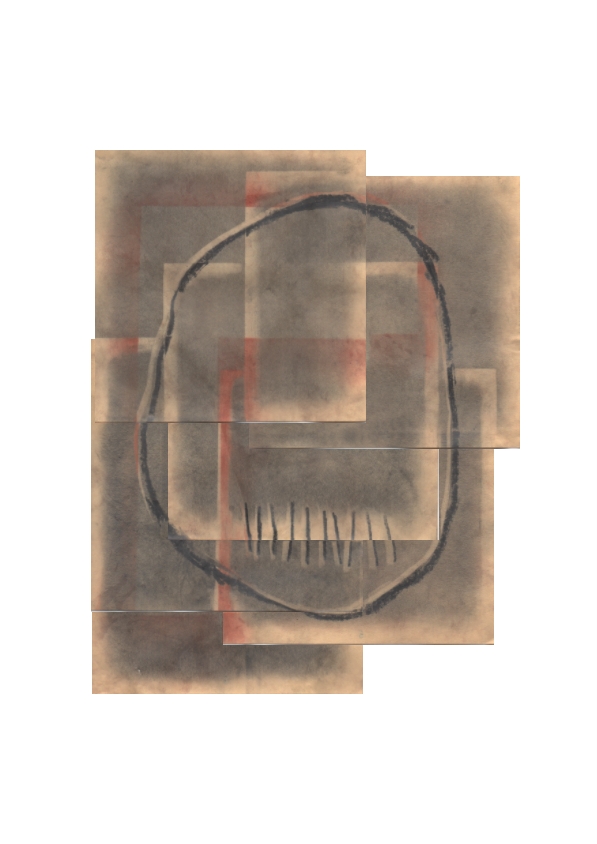
Collage from digitally printed paper, 27 x 21,5 cm. 3 unique works
This image is an upset face inspired in the “Constructivismo Universal”, Uruguayan artistic movement from the 20th century inspired in the Europeans vanguards.
300 € net
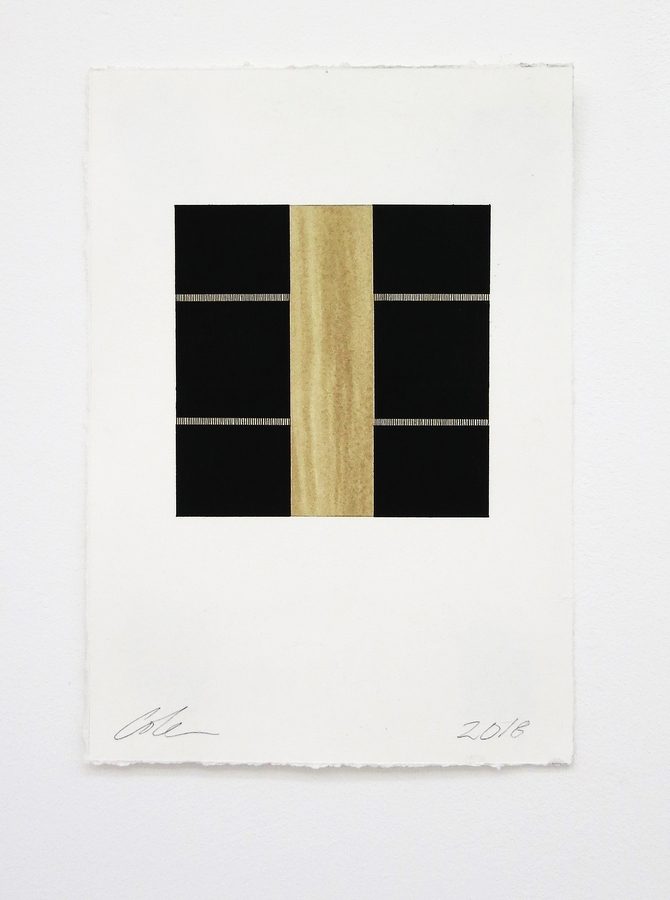
Digital print on cotton paper. 20 + 3 E.A.
This images derives from the work I have done for the past 5 or so years which began when I focused on the Greek Cross and the work of Malevich again. I first saw his art while I was a young student and have responded to the embrace of the mystical in art practiced by the Supremacists in my work since those early influences.
300 € net
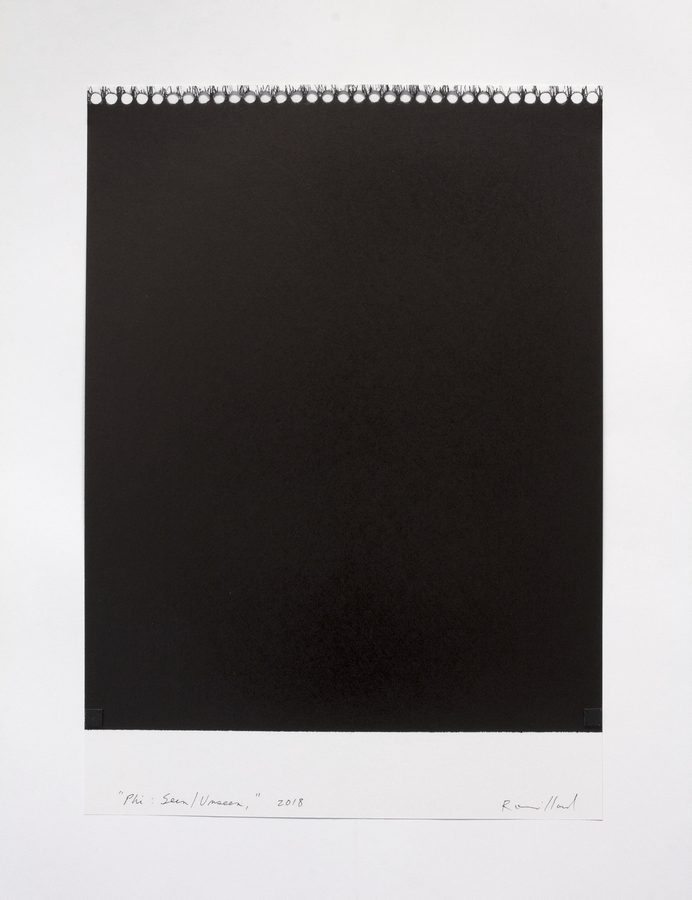
Ballpoint pen on paper. Series of unique works
The piece is done by holding 4 ballpoint pens in each hand and scribbling – treating the whole surface at once. The page is rotated in 4 directions and is then turned over to do the same thing to the reverse side. This is done repeatedly until the page is a densely saturated black. Line, by its sheer volume, becomes submerged into plane. The title is: “Phi: Seen/Unseen”. The overall proportions are of a Golden Section (Phi) but since the back of the page is also done only 1/2 of the piece is seen at any one time – hence the title.
2.200 € net
Unavailable
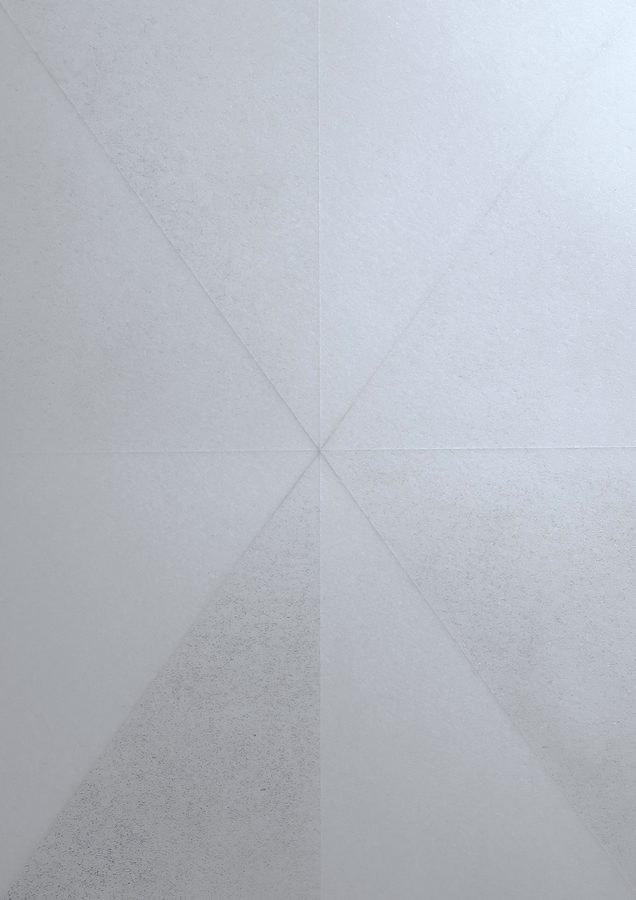
Silver spray on polyethylene. Unique + 3 E.A.
Using four corners of A4 size to parallelize the theory and practical duality. Looking back there towards the edge of corner. Looking at the space by the relationship between front and back and left and right. What is obtained from the difference of point of view and perspective.
480 € net
Unavailable
2200 Kugelschreiber und Plastikfolie auf Archivpapier. 25 + 3 E.A.
— die Plastiktütengriffverstärkung als fast schon brutal funktionsorientiertes und dennoch formschönes Massendesign für den täglichen Gebrauch
— der Kugelschreiberabrieb als organisch-organisierte strukturale Textur eine Hommage an die Textilwerkstätten des Bauhaus
450 € net
Please contact us for availability.
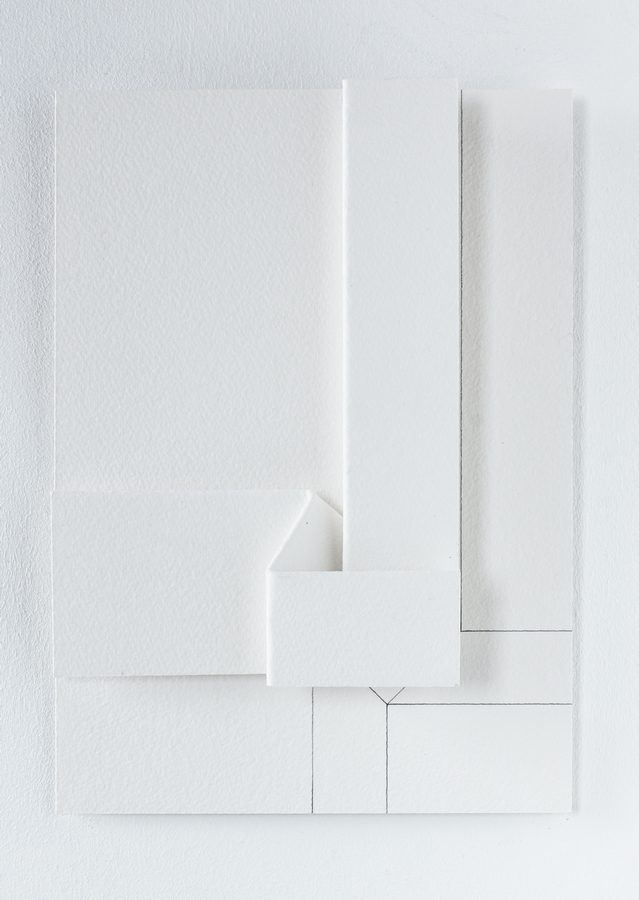
Canson Aquarellkarton, gefaltet. 6 + 1 E.A.
The idea is a homage to the architect and director of the Bauhaus, Walter Gropius. An even plane turns into architecture through folding the paper without any loss in the plane or surface. The ideal architecture which does not lose any of the construction material involved. The paper is a 300 g Canson watercolour cardboard which is folded without any cuts.
650 € net
Unavailable
Kunstharz auf 400 gr. Phönixmotion. 23 + 1 E.A.
Die A4 Blätter werden zu unterschiedlichen rechteckigen Behältnissen gefaltet, in die rote Kunstharzfarbe eingefüllt und wieder ausgegossen wird; anschließend werden die Blätter entfaltet und damit zurück in die Ebene gebracht. Zwei Formprinzipien wirken ineinander: das rechtwinklige „bauen“ und das organische Fließverhalten des Materials Farbe. Anwesenheit und Abwesenheit gleichzeitig.
750 € net
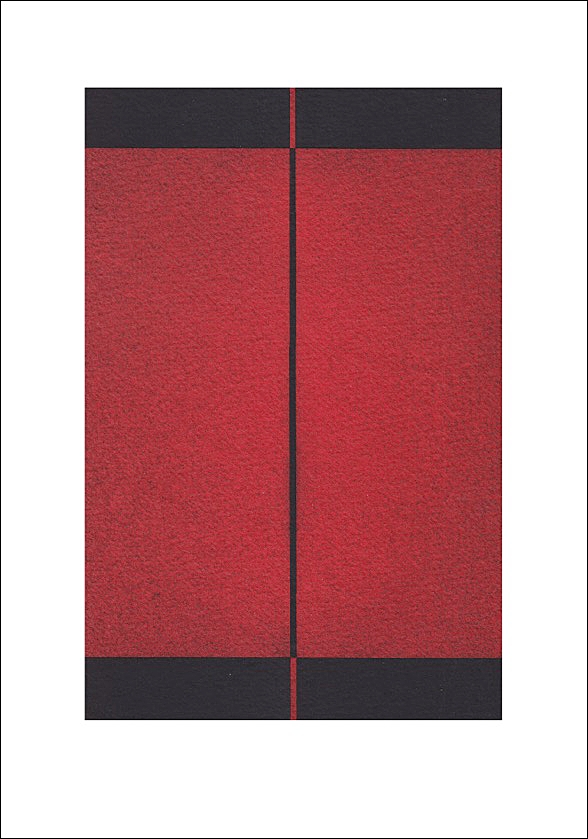
Digital print on Hahnemühle cotton rag paper. 25 + 3 E.A.
Intersect is a digital print of an original work using a self-invented technique combining acrylic colour and compressed charcoal.
It is one of a number of works, some individual, some serial, using the same tech-nique. All the work is based on principles similar to those developed by the Bauhaus artists and (especially) architects, in particular Mies van der Rohe, as well as other architects with a similarly radical, reductive aesthetic, such as Tadao Ando: that is, the arrangement and juxtapos-ition of basic forms, emphasizing the incidence of light and space, and openness.
Intersect ist ein Digitaldruck, der auf ein Originalbild basiert ist, das mittels einer selbsterfundenen Technik gemacht wurde: Eine Kombination von Acrylfarbe und Reißkohle. Es ist eine von etlichen, einzelnen als auch seriellen solchen Arbeiten. All diese Arbeiten sind auf ähnlichen Grundsätzen basiert, wie die, die die Künstler und, ins besondere, die Architekten des Bauhaus, vor allem Mies van der Rohe entwickelt haben, sowie auf das Werk anderer Architekten, wie z.B. Tadao Ando, mit einer gleichartigen, radikalen, reduktiven Aesthetik: d.h. die Anordnung und Juxtaposition von Grundformen, die Betonung auf Licht und Raum, und Offenheit.
225 € net
Digital print on cotton paper. 3 x 20 + 3 E.A.
Today, the historic Bauhaus is the most influential educational institution in the field of architecture, art and design in the 20th century. Exactly defined form without any randomness, clear contrasts, arrangement of elements, arrangement of identical parts in series and elsewhere. Simplicity in multiples, structuring of all construction units according to function. Words that describe my artworks, too… “colormirror views I-III“, 2018, digital prints that show my fluorescent artworks. My work allows an exploration in the relationship between colour, light, form and room. Utilizing industrially produced acrylic materials, almost fluorescent acrylic glass sheets that under black light come alive and turn into luminous light objects, coloured spaces change significantly the functional realities of the space and introduce possibilities of new experiences. With references to minimalism and concrete art, my light art create real colour rooms in athmospherically charged oscillations and generates almost physical palpable experiences. My work is about the constantly changing effects of light and colour; my artworks react to their surroundings and engage in a dialogue with each viewer. By transforming the thinking in colours and colour spaces into a spatially perceptible plasticity, the viewer finds a coloured sensuality in the perception of my works of art, which is able to cross borders. The editions created for the project capture the intention of my spatial works on a two-dimensional level and with their selected perspectives they give a specific impression of my work.
200 € net
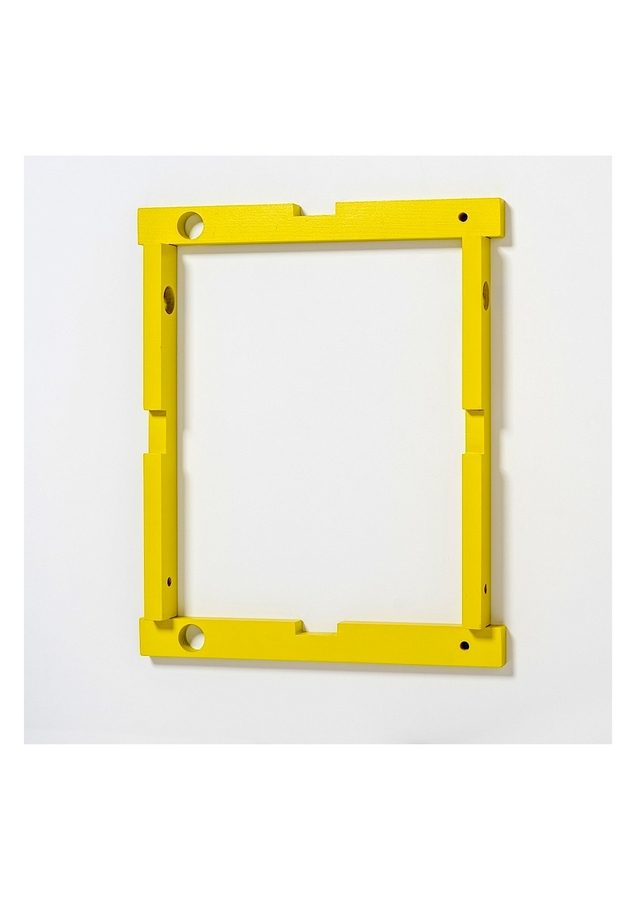
Digitaldruck eines Multiples aus 2017. 3 Exemplare
Bei seinen Werken verwendet René Zäch von Menschen geschaffene Dinge. Das Multiple «Alles im Lot» versteht sich als Teil einer kleinen Serie von Wandarbeiten und Grafiken aus den Jahren 2016/17. All diese Arbeiten basieren je auf zwei- oder dreidimensionalen Piktogrammen einer Wasserwaage.
Jeweils vier Wasserwaagen sind in einem Rechteck angeordnet an die Wand gehängt – vergleichbar mit einem Bilderrahmen. Die Prüfgeräte zur horizontalen oder vertikalen Ausrichtung eines Objektes befinden sich demnach alle im Lot. Es wird auf etwas Abwesendes verwiesen. Auf ein Bild, das fiktiv gemessen und im richtigen Winkel aufgehängt wird. In der formalen Einfachheit lässt das Werk an den Postminimalismus denken. Gleichzeitig befragt der Künstler aber die Ambivalenz zwischen dem Gebrauchsgegenstand und der Kunst und nutzt ein global verständliches Piktogramm, um etwas Abwesendes darzustellen und imaginär Neues zu schaffen. (Angela Nyffeler)
300 € net
One work available
Ballpoint pen and Inkjet print on paper. Series of unique works
Always working through series with works I develop concepts of colour, space,form and layering. By building up the surface of the material through the use of multiple passes in the printer. Structure is then implied by the addition of ballpoint pen drawn marks.
1.000 € net
Unavailable.
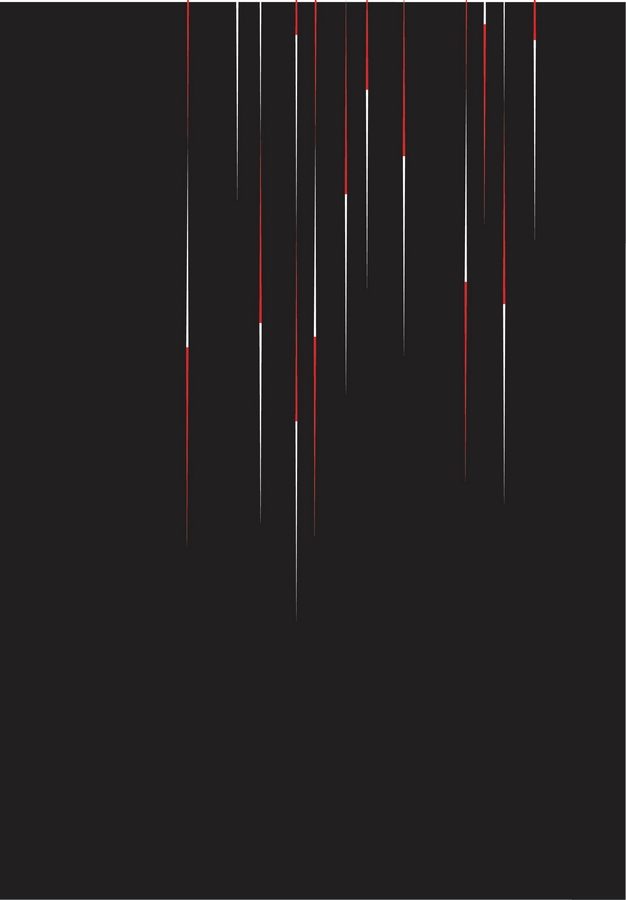
Digital Print on Paper. 20 + 3 E.A.
Formal abstractions that flirt with popular culture, my work involves my interest in play, the quotidian, and the “retinal.” My present practice is a return home. I painted for many years, then for approximately ten years my practice became more conceptual – creating collections of contemporary material culture. I returned to painting in 2006 with a renewed and revitalized interest, fueled by conceptualism and informed by postmodern attitudes.
300 € net
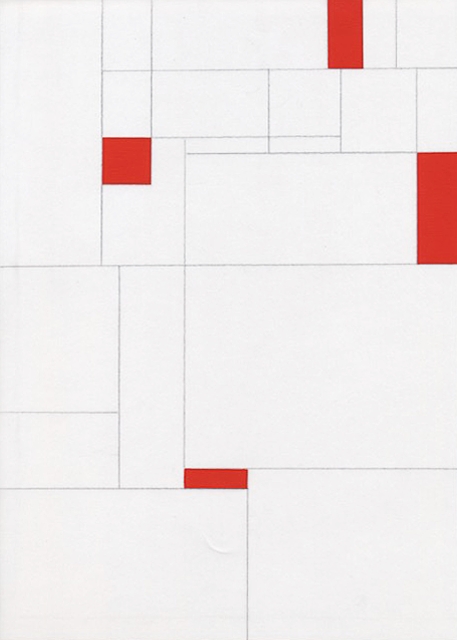
Drawing on Opalux (Transparent Paper) of Acrylic. Edition 3
Das Bauhaus steht für mich für Experiment, Aufbruch, Hoffnung und grosse Energie. In meiner Arbeit suche ich die Verbindung von Vergangenheit und Gegenwart. In meiner konstruktiven Sprache beschäftigen mich die Basis, die Grundstruktur und der Grundriss in der Architektur. Für BAUHAUS habe ich einen Ausschnitt von einem Plan von Mies van der Rohe ausgewählt, zumal Mies van der Rohe ab 1930 drei Jahre lang Direktor am Bauhaus war. 2011 konnte ich eine Ausstellung in Dessau realisieren zum 125. Geburtstag von Mies van der Rohe im Meisterhaus Muche/Schlemmer.
For me, the Bauhaus stands for experiment, awakening, hope and great energy. In my work, i seek for the connection between past and present time. In my own constructive language, i am concerned with the basis, the basic structure and the ground plan in architecture. For BAUHAUS I selected part of a plan by Mies van der Rohe, especially since Mies van der Rohe, starting in 1930 until 1933, was director of the Bauhaus. In 2011, on the occasion of the 125th birthday of Mies van der Rohe, I realized an exhibition in Dessau in the Meisterhaus Muche/Schlemmer
800 € net
One work available
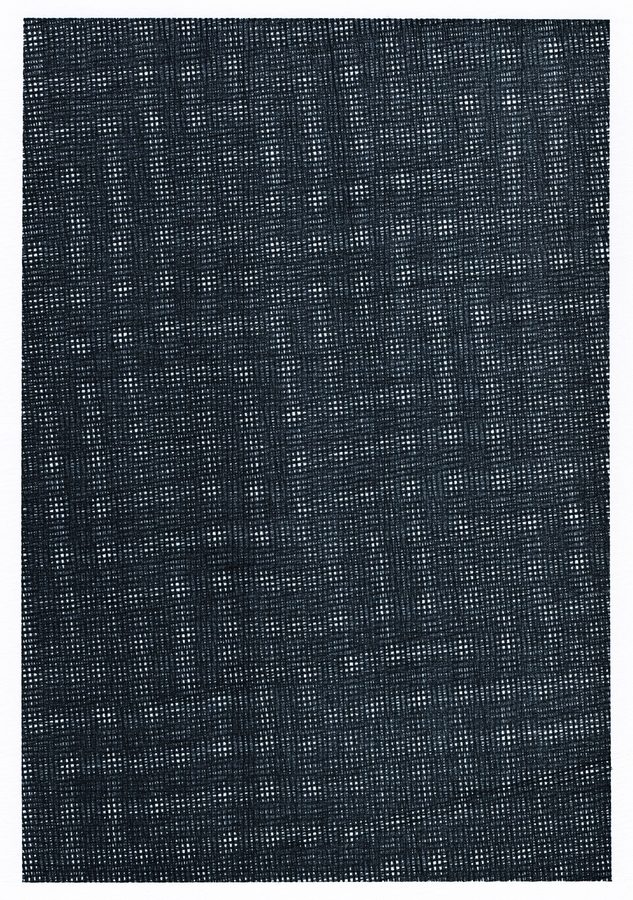
Archival Print on Cotton Paper. 30 + 3 E.A.
Using basic means of pencil on paper and utilizing a systematic approach to overlaying a multitude of straight lines I invite the parameters of this system to break down, disintegrate or fall apart. This is only apparent through the process of making the work, as the build-in intuitive decisions are the inevitable deviations or glitches.
200 € net
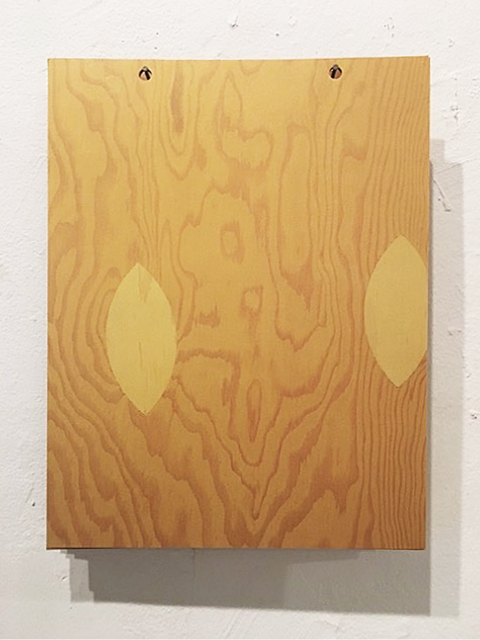
Digital Print on Cotton Paper, 28 x 21,5 cm. Unlimited Edition to be printed on demand in the spirit of endless production.
In as much as the idea that the Bauhaus engaged artists in the practice of being cultural producers, the industrial process and product itself fulfilled the initiation of a new aesthetic.
The work I have contributed to this exhibition seeks to simply to provide a series of samples that may be further reproduced, exploring the seminal state of that objective.
250 € net for each sample sheet (recommended a minimum of 3)
Drawing on transparent paper. 3 unique sheets
Interlace Variations 1–3 are enlarged weave draft abstractions.
880 € net
Unavailable
Gouache on Cotton Paper. Unique works
In my canvas works, I let the colour flow onto the canvas. The specific edges and colour gradients result depending on whether the colour is thin or viscous and on whether the surface of the picture is particularly wet or dry. A principle that brings with it a lot of moments that I can integrate or reject, but I can not paint it in the true sense. Accordingly now, I have chosen in the paper works, the principle of immersion (the paper in a tub of colour). The fields and edges of the colours are determined by this process. At the same time the papers are double-sided and have no fixed front and back.
250 € net
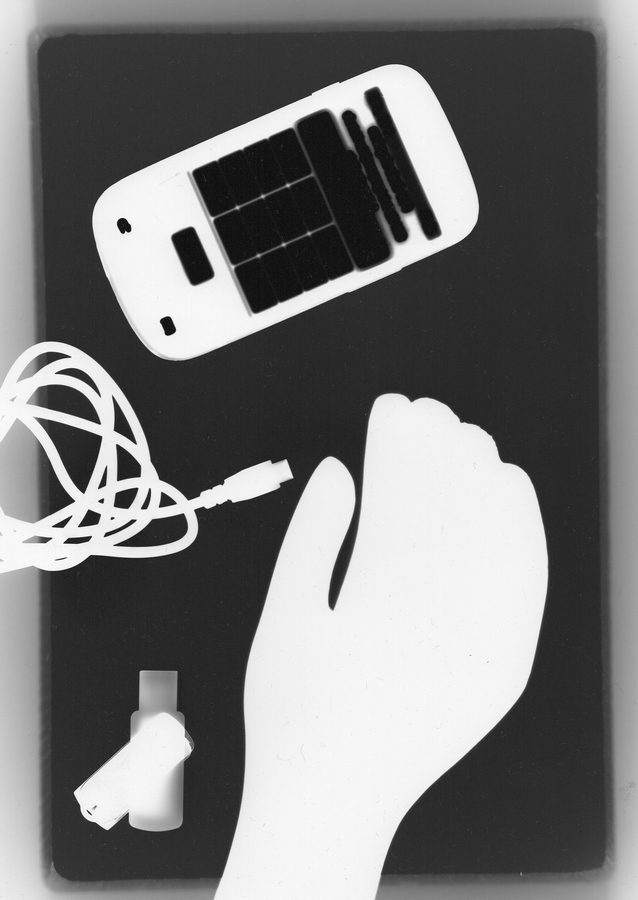
Photogram on Photographic Paper. 3 unique works
Das Smartphone ist das am weitesten verbreitete und am radikalsten gestaltete Industrieprodukt der Welt. In der Arbeit Electronic Fingerprint wird es als bildnerisches Mittel in der Tradition der Fotogramme von Moholy-Nagy und Gyorgy Kepes verwendet. Die tiefste Schwärze der Graphik – die sich auf dem klassischem Fotopapier nur durch starke Bestrahlung durch Licht oder dem Wirken elektrischer Spannung einstellen kann ergab sich unter dem abgeschaltetem !! Display.
100 € net
Unavailable
seidenmatt Latex auf 350g Papier, 28 x 22 cm. 15 + 3 E.A.
(…) “the image that is referring to itself, represents an ideological starting point. As part of our awareness process, it stimulates and sharpens the experience of light, space and time. Sometimes as a critical, independent commentary, but above all as the materialization of the believe in beauty and quality.”
Sigmund de Jong
750 € net
Acrylic on Paper. 3 + 1 E.A.
„Madras Check“ to me stands for the archetypal quality of an open yet straight forward textile design principle. It is the mixture of colour between warp and weft threads which yield the tonal subtleties in square color blocks that make the appearance of this type of fabric so universally aestethic. In using narrow and broad brush strokes of watercolour my aim is to reenact the same principles that are so characteristic for „Madras“ in a painterly manner. As seen from a modernist point of view this textile approach to design yields the utmost clarity of a non-objective colour space, letting the transparent layers of watercolour interact with each other thereby creating all the nuances of mixed shades that are to be obtained in glazing.
350 € net
Pencil drawing on Paper, 3 unique works
My drawings for CENTURY. idee bauhaus began with following the Manifesto of the Staatliches Bauhaus by Walter Gropius (1919) and his edict that “the basis of craftsmanship is indispensable to all artists. It is the prime source of all creative work.” I became a beginner again and studied the lessons taught by Johannes Itten at the Bauhaus. He began his classes with relaxation, breathing and concentration exercises as did I. Then each day I followed one of his lessons in developing skills and vision. Exercise of line compositions in the character of a triangle examined the relationships between triangular forms and the lines that comprised them. Transparent Opaque was an illuminating lesson in value and line and the illusion of transparency and opacity. As I completed each exercise, I gained some insight and craftsmanship. Through my Daily Drawing practice I continue to practice Itten’s exercises, developing further insights into the Bauhaus and the pure distillation evident in its teachings.
1.275 € net
One work available
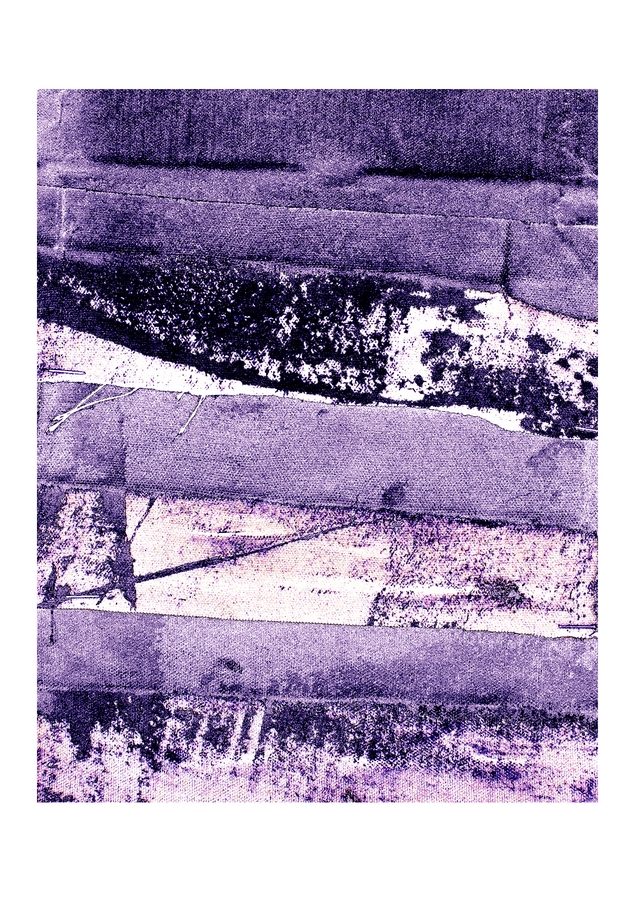
Digital Print on Canford Paper. 20 + 3 E.A.
This photographic print is a detail section from one of my paintings. I have inverted the original image, and then further edited and abstracted it – blending the physical process of painting with the digital world of photoshop. I am interested in the borer between the hand made vs the virtually produced. How a traditional historic medium like painting can be modernised by using a contemporary medium like photoshop. And also how the manual 3d making of works in my studio can be transferred and reproduced into a 2d medium – and hence taking on a whole new life form.
200 € net
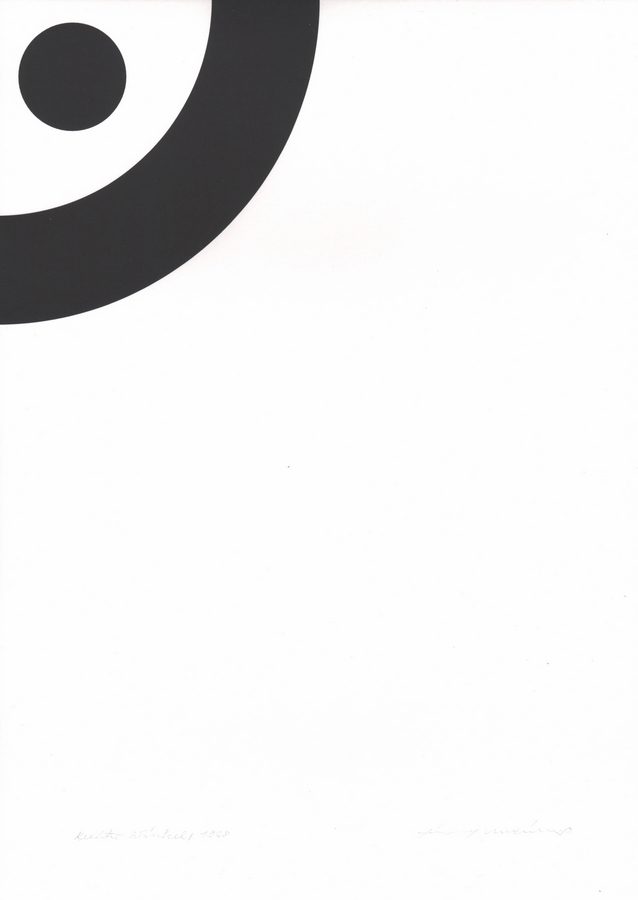
Digitaldruck. 7 Exemplare
Gewiss, ich weiß, dass das Bauhaus sich nicht auf den rechten Winkel reduzieren lässt, aber das 90°-Zeichen gefällt mir doch ganz gut, nicht nur beim Fußball-Eckstoß. Bei meiner Ausstellung im Krefelder Haus Lange 1970 hatte ich es mehrfach groß ins Treppenhaus geklebt, und 2010 im Museum Ritter sogar plastisch gemacht (4x); das ist auch im Katalog abgebildet. Als grafisches Blatt hatte ich’s noch nicht.
120 € net
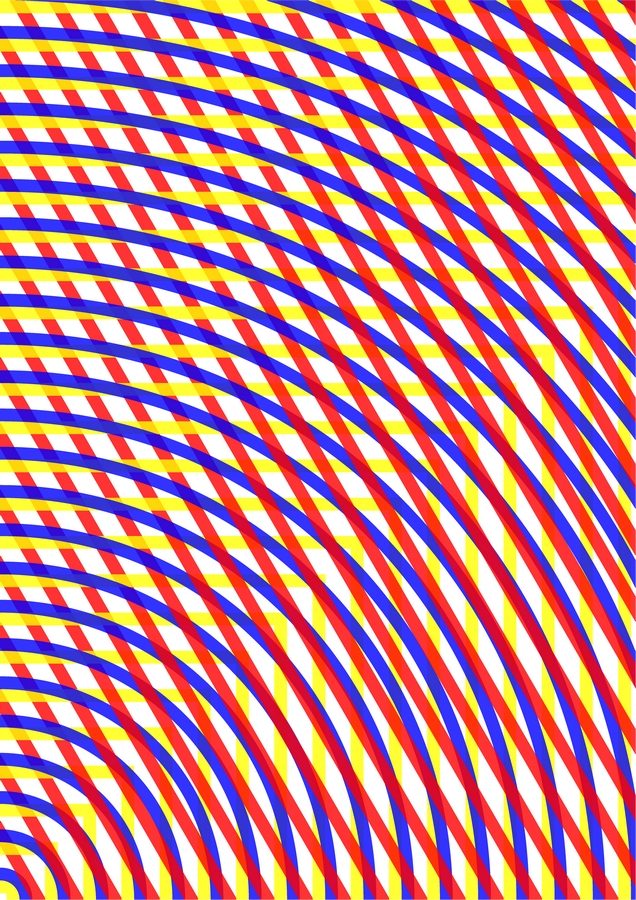
Digital Print on Cotton Paper. 30 + 3 E.A.
The three basic shapes
in the three basic colours
copied thirty times.
150 € net
Wolfgang Berndt [*1953 · DE]. typomaze, 2018.
Digital print on watercolour paper.
3 unique works
Neben meiner jüngeren Beschäftigung mit der Weberei (“Das Bauhaus webt”), natürlich unter algorithmischen Gesichtspunkten, gilt mein besonderes Interesse seit den 90er Jahren der (Mikro-/Makro-) Typographie und dort insbesondere dem Bauhaus und seinen Vertretern und Nicht-Vertretern (z.B. Tschichold). Verbindungen erstehen immer wieder aus der Zeichenhaftigkeit meiner generativen Irrgärten (mazes -> typomazes).
280 € net
One work available
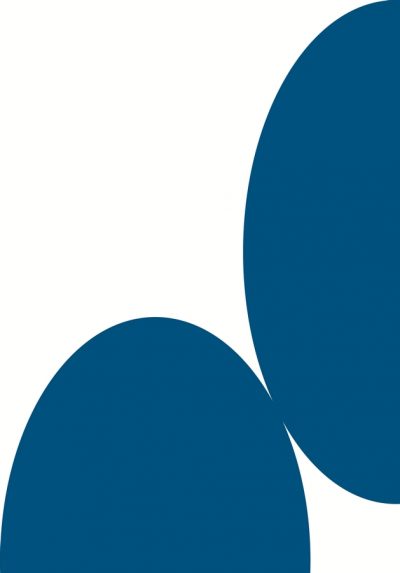
Digital Print auf Karton. 20 + 3 E.A.
Auf der Grafik werden zwei Ellipsen jeweils durch die rechte und die untere Blattkante in zwei unterschiedliche, aber gleichgroße Hälften, geteilt. Die genaue Platzierung auf dem DIN-A4-Format und der Berührungspunkt beider Ausschnitte ergeben sich aus festgelegten Proportionen innerhalb der geometrischen Ausgangsform. Die Position der zwei halben Ellipsen markiert den Grundriss für eine zweiteilige Skulptur aus geschnittenen ellipsoiden Körpern. Diese werden aus einem schwarzen Stein gearbeitet und haben eine mattgeschliffene Oberfläche, die das Licht absorbiert. Es entsteht eine Spannung, einerseits in der Konstellation zwischen den Objekten untereinander und anderseits aber auch in der Skulptur selbst, die durch die präzise Oberflächengestaltung und dem Material statisch wirkt, in sich ruht.
120 € net
Naturally dyed silk threads on wood panel. 3 unique works
Rather than overwriting the artist’s identity over objects, overwriting the personality of objects against the identity expressed by the artist.
Sold out.
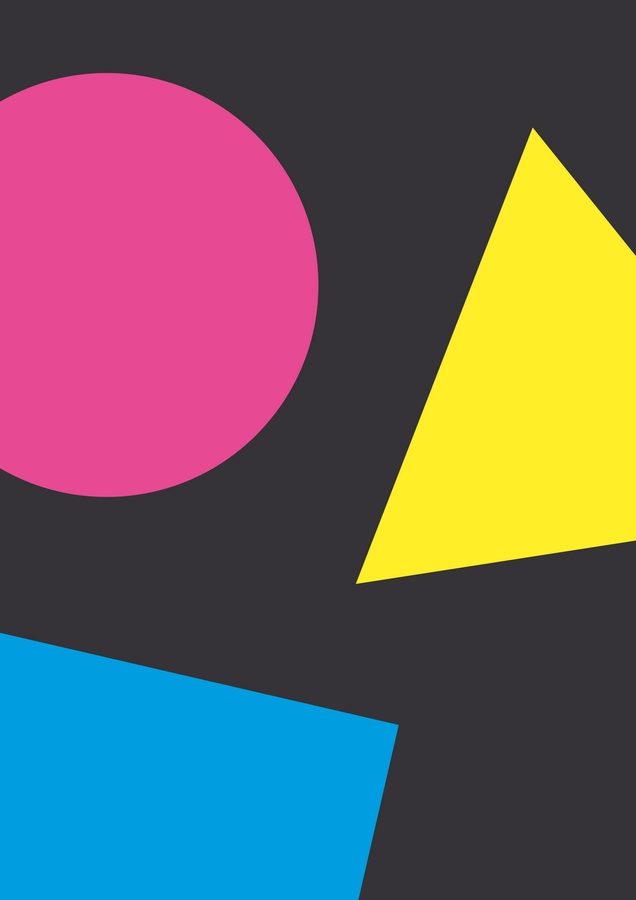
Silkscreen on paper. 20 + E.A.
Circle. Triangle. Square. These three geometric emblems of the Bauhaus are fundamental to my artistic work. I am drawn to their independent clarity and balance as well as to the tensions and surprises they provoke. For the screenprint, instead of the primary colours of Bauhaus, I brought these shapes into contact with my own palette: neon yellow, neon pink, and light blue against a dark grey background.
350 € net